en
CNTS_000000000021616
c6
Theme Travel
contentscd>c6
Finding Sumbi - Haenyeo: Mothers of Jeju
16
Gujwa
region1>16
Museums,Jeju Women Divers,Indoors,Exhibition/Event,Cultural Heritage,On Foot,museum,beach,funinthewater
As you walk along the winding path of a wide-open beach, an oddly soft yet sharp sound bounces across the waves. You look around to see who is making this high-pitched whistle, but there’s no one around. As you continue to look for the source, you hear the whistle again.
4391
0
0
0
0
0
0
Finding Sumbi - Haenyeo: Mothers of Jeju
63362
--
33.523525
126.86349
<ol class="ui-sortable" id="sortable" type="I" style="list-style: none; margin: 0px; padding: 0px;">
<li class="ui-sortable-handle"><a class="btn btn-black moveBtn" style="height: 30px; float: left; display: none; cursor: move;" href="javascript:void(0)">이동</a><a class="btn btn-black delEditor" style="width: 30px; padding-left: 10px; float: left;" onclick="sectionDel(this)">DEL</a>
<div title="Rich Text Editor, editor0" class="editorCls cke_editable cke_editable_inline cke_contents_ltr cke_focus cke_show_borders" id="editor0" role="textbox" aria-describedby="cke_202" style="position: relative;" contenteditable="false" spellcheck="false" aria-label="Rich Text Editor, editor0"><link href="http://www.visitjeju.net/css/theme.css" rel="stylesheet" type="text/css"><div id="body_theme"><div id="body_contents"><!--{cke_protected}{C}%3C!%2D%2D%20%EC%83%81%EB%8B%A8%20%ED%83%80%EC%9D%B4%ED%8B%80%2F%ED%94%84%EB%A1%A4%EB%A1%9C%EA%B7%B8%20%2D%2D%3E--><div class="margin_10"><br></div><div class="subtitle">Symbols of Jeju, strong Jeju haenyeo diving women</div><div class="margin_15"><br></div><div class="title">Finding Sumbi - Haenyeo: Mothers of Jeju</div><div class="margin_30"><br></div><div class="prologue">‘Ho-oi~ ho-oi~’<br><br>As you walk along the winding path of a wide-open beach, an oddly soft yet sharp sound bounces across the waves. You look around to see who is making this high-pitched whistle, but there’s no one around. As you continue to look for the source, you hear the whistle again: ‘Ho-oi~’. Ah, it’s coming from out in the ocean, sounding with the waves. Yes. This is the famed ‘sumbi’ sound made by the haenyeo diving women, the mermaids of the Jeju sea.<br><br>The sound is a bit like the soft chirp of a little bird singing across the ocean waves. However, it’s actually the haenyeo’s rapid exhalation of breath after spending some minutes working underwater freediving for marine products on the ocean floor. If you visit or live on Jeju Island, there’s a good chance you’ll get to hear this unique sound at some time or other. The experience is unforgettable! Right in front of your eyes, Jeju women are working in the ocean as they have done for centuries. The haenyeo are truly guardians of not only the Jeju marine environment, but of an island culture and skill that is rapidly becoming an endangered heritage. </div><!--{cke_protected}{C}%3C!%2D%2D%20%EC%83%81%EB%8B%A8%20%ED%83%80%EC%9D%B4%ED%8B%80%2F%ED%94%84%EB%A1%A4%EB%A1%9C%EA%B7%B8%20%2D%2D%3E--><div class="margin_40"><br></div><div class="img_100"><span tabindex="-1" contenteditable="false" data-cke-widget-wrapper="1" data-cke-filter="off" class="cke_widget_wrapper cke_widget_inline cke_widget_image cke_image_nocaption" data-cke-display-name="image" data-cke-widget-id="27" role="region" aria-label=" image widget"><img width="1160" height="550" class="img_100 cke_widget_element" alt="" src="/ckImage/201700/ckeditor_6161891713415036555.jpg" data-widget="image" data-cke-widget-keep-attr="0" data-cke-widget-upcasted="1" data-cke-widget-data="%7B%22hasCaption%22%3Afalse%2C%22src%22%3A%22%2FckImage%2F201700%2Fckeditor_6161891713415036555.jpg%22%2C%22alt%22%3A%22%22%2C%22width%22%3A%221160%22%2C%22height%22%3A%22550%22%2C%22lock%22%3Atrue%2C%22align%22%3A%22none%22%2C%22classes%22%3A%7B%22img_100%22%3A1%7D%7D" data-cke-saved-src="/ckImage/201700/ckeditor_6161891713415036555.jpg" imgwriter="undefined"><span class="cke_reset cke_widget_drag_handler_container" style="background: url("http://www.visitjeju.net/jtotour/cms/ckeditor/plugins/widget/images/handle.png") rgba(220, 220, 220, 0.5); top: -15px; left: 0px; display: block;"><img class="cke_reset cke_widget_drag_handler" data-cke-widget-drag-handler="1" src="data:image/gif;base64,R0lGODlhAQABAPABAP///wAAACH5BAEKAAAALAAAAAABAAEAAAICRAEAOw==" width="15" title="Click and drag to move" height="15" role="presentation" draggable="true"></span><span class="cke_image_resizer" title="Click and drag to resize"></span></span></div><div class="margin_30"><br></div><!--{cke_protected}{C}%3C!%2D%2D%20%EC%83%81%EB%8B%A8%20%ED%83%80%EC%9D%B4%ED%8B%80%2F%ED%95%98%EB%8B%A8%20%ED%85%8D%EC%8A%A4%ED%8A%B8%20%2D%2D%3E--><div class="title_and_text"><div class="mini_title2">The destiny of Jeju women turns into an 'orange flower'</div><div class="margin_5"><br></div><div class="mini_title_bold2">Jeju Haenyeo</div><div class="margin_10"><br></div><div class="underline1"><br></div><div class="margin_30"><br></div><div class="the_body_text">When you walk along the beach, you will be able to see countless orange “flowers” that decorate the sea of Jeju and hear the sumbisori whistles that resound nearby. These are signs that the haenyeo diving women, the flowers of Jeju, are working under the sea. <br><br>Of course, you won’t find them fishing every day. It is not about the size of the waves or how strong or weak the wind is. Rather, the haenyeo work according to the tides. The days that the Jeju haenyeo can fish are when the tides are comparatively weak, approximately the 8th to 14th and 23rd to 29th of each month based on the lunar calendar. So based on this calculation, there are only about 100 working days out of 365.<br><br>Even then, if the weather is poor, it’s hard for the haenyeo to do their work safely. This means that even if you drive all the way into the countryside to see the Jeju diving women, there’s a chance you’ll miss them altogether. </div></div><div class="margin_30"><br></div><!--{cke_protected}{C}%3C!%2D%2D%20%EC%9D%B4%EB%AF%B8%EC%A7%80%202%EA%B0%9C%20%2D%2D%3E--><div class="width_100"><div class="img_50_1"><span tabindex="-1" contenteditable="false" data-cke-widget-wrapper="1" data-cke-filter="off" class="cke_widget_wrapper cke_widget_inline cke_widget_image cke_image_nocaption" data-cke-display-name="image" data-cke-widget-id="26" role="region" aria-label=" image widget"><img width="1200" height="799" class="img_100 cke_widget_element" alt="" src="/ckImage/201700/ckeditor_5165218006659041387.jpg" data-widget="image" data-cke-widget-keep-attr="0" data-cke-widget-upcasted="1" data-cke-widget-data="%7B%22hasCaption%22%3Afalse%2C%22src%22%3A%22%2FckImage%2F201700%2Fckeditor_5165218006659041387.jpg%22%2C%22alt%22%3A%22%22%2C%22width%22%3A%221200%22%2C%22height%22%3A%22799%22%2C%22lock%22%3Atrue%2C%22align%22%3A%22none%22%2C%22classes%22%3A%7B%22img_100%22%3A1%7D%7D" data-cke-saved-src="/ckImage/201700/ckeditor_5165218006659041387.jpg" imgwriter="undefined"><span class="cke_reset cke_widget_drag_handler_container" style="background:rgba(220,220,220,0.5);background-image:url(http://www.visitjeju.net/jtotour/cms/ckeditor/plugins/widget/images/handle.png)"><img class="cke_reset cke_widget_drag_handler" data-cke-widget-drag-handler="1" src="data:image/gif;base64,R0lGODlhAQABAPABAP///wAAACH5BAEKAAAALAAAAAABAAEAAAICRAEAOw==" width="15" title="Click and drag to move" height="15" role="presentation" draggable="true"></span><span class="cke_image_resizer" title="Click and drag to resize"></span></span></div><div class="img_50_2"><span tabindex="-1" contenteditable="false" data-cke-widget-wrapper="1" data-cke-filter="off" class="cke_widget_wrapper cke_widget_inline cke_widget_image cke_image_nocaption" data-cke-display-name="image" data-cke-widget-id="25" role="region" aria-label=" image widget"><img width="1200" height="799" class="img_100 cke_widget_element" alt="" src="/ckImage/201700/ckeditor_6695295842528713059.jpg" data-widget="image" data-cke-widget-keep-attr="0" data-cke-widget-upcasted="1" data-cke-widget-data="%7B%22hasCaption%22%3Afalse%2C%22src%22%3A%22%2FckImage%2F201700%2Fckeditor_6695295842528713059.jpg%22%2C%22alt%22%3A%22%22%2C%22width%22%3A%221200%22%2C%22height%22%3A%22799%22%2C%22lock%22%3Atrue%2C%22align%22%3A%22none%22%2C%22classes%22%3A%7B%22img_100%22%3A1%7D%7D" data-cke-saved-src="/ckImage/201700/ckeditor_6695295842528713059.jpg" imgwriter="undefined"><span class="cke_reset cke_widget_drag_handler_container" style="background:rgba(220,220,220,0.5);background-image:url(http://www.visitjeju.net/jtotour/cms/ckeditor/plugins/widget/images/handle.png)"><img class="cke_reset cke_widget_drag_handler" data-cke-widget-drag-handler="1" src="data:image/gif;base64,R0lGODlhAQABAPABAP///wAAACH5BAEKAAAALAAAAAABAAEAAAICRAEAOw==" width="15" title="Click and drag to move" height="15" role="presentation" draggable="true"></span><span class="cke_image_resizer" title="Click and drag to resize"></span></span></div></div><div class="margin_30"><br></div><!--{cke_protected}{C}%3C!%2D%2D%20%EA%B8%802%EB%8B%A8%EB%9D%BD%20%2D%2D%3E--><div class="width_100"><div class="the_body_text3_1">In the old days, the women of Jeju did not have much of a choice regarding their destinies. They had to follow the will of their family, which due to the relative prosperity of those who dove, meant that they, too, would become haenyeo. With their mothers, girls as young as 7 or 8 would start learning to swim at shallow beaches, and by the time they were 12 or 13 would venture into deeper areas along the coast to train.</div><div class="the_body_text3_2">With many years of practise, by the time they were 15 or 16 the Jeju young girls could start working and eventually become strong, independent members of an elite community of divers, women who devote their entire lives to fishing under the sea.</div></div><div class="margin_30"><br></div><!--{cke_protected}{C}%3C!%2D%2D%20%EC%9D%B4%EB%AF%B8%EC%A7%80%201%EA%B0%9C%20%2D%2D%3E--><div class="img_100"><span tabindex="-1" contenteditable="false" data-cke-widget-wrapper="1" data-cke-filter="off" class="cke_widget_wrapper cke_widget_inline cke_widget_image cke_image_nocaption" data-cke-display-name="image" data-cke-widget-id="24" role="region" aria-label=" image widget"><img width="1160" height="550" class="img_100 cke_widget_element" alt="" src="/ckImage/201700/ckeditor_1498602931203281548.jpg" data-widget="image" data-cke-widget-keep-attr="0" data-cke-widget-upcasted="1" data-cke-widget-data="%7B%22hasCaption%22%3Afalse%2C%22src%22%3A%22%2FckImage%2F201700%2Fckeditor_1498602931203281548.jpg%22%2C%22alt%22%3A%22%22%2C%22width%22%3A%221160%22%2C%22height%22%3A%22550%22%2C%22lock%22%3Atrue%2C%22align%22%3A%22none%22%2C%22classes%22%3A%7B%22img_100%22%3A1%7D%7D" data-cke-saved-src="/ckImage/201700/ckeditor_1498602931203281548.jpg" imgwriter="undefined"><span class="cke_reset cke_widget_drag_handler_container" style="background: url("http://www.visitjeju.net/jtotour/cms/ckeditor/plugins/widget/images/handle.png") rgba(220, 220, 220, 0.5); top: -15px; left: 0px; display: block;"><img class="cke_reset cke_widget_drag_handler" data-cke-widget-drag-handler="1" src="data:image/gif;base64,R0lGODlhAQABAPABAP///wAAACH5BAEKAAAALAAAAAABAAEAAAICRAEAOw==" width="15" title="Click and drag to move" height="15" role="presentation" draggable="true"></span><span class="cke_image_resizer" title="Click and drag to resize"></span></span></div><div class="margin_30"><br></div><!--{cke_protected}{C}%3C!%2D%2D%20%EA%B8%801%EB%8B%A8%EB%9D%BD%20%2D%2D%3E--><br><!--{cke_protected}{C}%3C!%2D%2D%20%EA%B5%AC%EB%B6%84%EC%84%A0%20%2D%2D%3E--><div class="margin_40"><br></div><div class="underline2"><br></div><div class="margin_40"><br></div><!--{cke_protected}{C}%3C!%2D%2D%20%EC%9D%B4%EB%AF%B8%EC%A7%80%201%EA%B0%9C%20%2D%2D%3E--><div class="img_100"><span tabindex="-1" contenteditable="false" data-cke-widget-wrapper="1" data-cke-filter="off" class="cke_widget_wrapper cke_widget_inline cke_widget_image cke_image_nocaption" data-cke-display-name="image" data-cke-widget-id="23" role="region" aria-label=" image widget"><img width="1160" height="600" class="img_100 cke_widget_element" alt="" src="/ckImage/201700/ckeditor_6601249472634168735.jpg" data-widget="image" data-cke-widget-keep-attr="0" data-cke-widget-upcasted="1" data-cke-widget-data="%7B%22hasCaption%22%3Afalse%2C%22src%22%3A%22%2FckImage%2F201700%2Fckeditor_6601249472634168735.jpg%22%2C%22alt%22%3A%22%22%2C%22width%22%3A%221160%22%2C%22height%22%3A%22600%22%2C%22lock%22%3Atrue%2C%22align%22%3A%22none%22%2C%22classes%22%3A%7B%22img_100%22%3A1%7D%7D" data-cke-saved-src="/ckImage/201700/ckeditor_6601249472634168735.jpg" imgwriter="undefined"><span class="cke_reset cke_widget_drag_handler_container" style="background: url("http://www.visitjeju.net/jtotour/cms/ckeditor/plugins/widget/images/handle.png") rgba(220, 220, 220, 0.5); top: -15px; left: 0px; display: block;"><img class="cke_reset cke_widget_drag_handler" data-cke-widget-drag-handler="1" src="data:image/gif;base64,R0lGODlhAQABAPABAP///wAAACH5BAEKAAAALAAAAAABAAEAAAICRAEAOw==" width="15" title="Click and drag to move" height="15" role="presentation" draggable="true"></span><span class="cke_image_resizer" title="Click and drag to resize"></span></span></div><div class="margin_20"><br></div><!--{cke_protected}{C}%3C!%2D%2D%20%EC%99%BC%EC%AA%BD%20%ED%83%80%EC%9D%B4%ED%8B%80%2F%EC%98%A4%EB%A5%B8%EC%AA%BD%20%ED%85%8D%EC%8A%A4%ED%8A%B8%20%2D%2D%3E--><div class="title_and_text"><div class="mini_title_wrap"><div class="mini_title2">The lives of Jeju haenyeo ‘at a glance’</div><div class="margin_5"><br></div><div class="mini_title_bold2">Jeju Haenyeo Museum</div><div class="margin_20"><br></div><div class="underline1"><br></div><div class="margin_20"><br></div></div><div class="the_body_text">It’s not entirely possible to understand the haenyeo culture and history simply by watching them work in the ocean. Rather, you need to visit the Jeju Haenyeo Museum near Sehwa Beach in Gujwa-eup, Jeju-si. The three-story museum, which opened in 2006, has a total floor area of 4000m2 with three exhibit halls, one theater, an observatory, and one arts hall for children. Each exhibit hall has its own theme. Exhibit Hall No. 1 has the theme of the ‘daily routine of haenyeo’. It recreates a typical haenyeo house, fishing village, and the overall presentation of a fishing village. Exhibit Hall No. 2 has the theme of the ‘workplace of the haenyeo’. It contains information about the women divers’ community and history, as well as a recreated ‘bulteok’ (a space where haenyeo could rest and change in and out of their diving year protected from the strong wind) and other fishing tools. Exhibit Hall No. 3 has the theme of the ‘life of the haenyeo’. Here, visitors can indirectly experience the life of the haenyeo, young women who went from being young girls afraid of the sea to skilled women divers. </div></div><!--{cke_protected}{C}%3C!%2D%2D%20%EC%99%BC%EC%AA%BD%20%ED%83%80%EC%9D%B4%ED%8B%80%2F%EC%98%A4%EB%A5%B8%EC%AA%BD%20%ED%85%8D%EC%8A%A4%ED%8A%B8%20%2D%2D%3E--><div class="margin_30"><br></div><!--{cke_protected}{C}%3C!%2D%2D%20%EC%A3%BC%EC%86%8C%EC%A0%95%EB%B3%B4%EB%B0%95%EC%8A%A4%20%EC%8B%9C%EC%9E%91%2D%2D%3E--><div class="graybox"><div class="mini_title3"><span class="font_bold">Jeju Haenyeo Museum</span><a class="mapmark_link" href="http://www.visitjeju.net/ko/tourView.jto?menuCd=DOM_000001717006000000&areaId=CONT_000000000500580" target="_blank" data-cke-saved-href="http://www.visitjeju.net/ko/tourView.jto?menuCd=DOM_000001717006000000&areaId=CONT_000000000500580">정보 자세히 보기 ></a></div><div class="margin_10"><br></div><div class="underline2"><br></div><div class="margin_10"><br></div><div class="the_body_add"><div class="width_100"><span class="add_title"><span tabindex="-1" contenteditable="false" data-cke-widget-wrapper="1" data-cke-filter="off" class="cke_widget_wrapper cke_widget_inline cke_widget_image cke_image_nocaption" data-cke-display-name="image" data-cke-widget-id="22" role="region" aria-label=" image widget"><img class="icon cke_widget_element" alt="" src="http://jejutravellab.com/test/img/icon/map.png" data-widget="image" data-cke-widget-keep-attr="0" data-cke-widget-upcasted="1" data-cke-widget-data="%7B%22hasCaption%22%3Afalse%2C%22src%22%3A%22http%3A%2F%2Fjejutravellab.com%2Ftest%2Fimg%2Ficon%2Fmap.png%22%2C%22alt%22%3A%22%22%2C%22width%22%3A%22%22%2C%22height%22%3A%22%22%2C%22lock%22%3Atrue%2C%22align%22%3A%22none%22%2C%22classes%22%3A%7B%22icon%22%3A1%7D%7D" data-cke-saved-src="http://jejutravellab.com/test/img/icon/map.png" imgwriter="undefined"><span class="cke_reset cke_widget_drag_handler_container" style="background:rgba(220,220,220,0.5);background-image:url(http://www.visitjeju.net/jtotour/cms/ckeditor/plugins/widget/images/handle.png)"><img class="cke_reset cke_widget_drag_handler" data-cke-widget-drag-handler="1" src="data:image/gif;base64,R0lGODlhAQABAPABAP///wAAACH5BAEKAAAALAAAAAABAAEAAAICRAEAOw==" width="15" title="Click and drag to move" height="15" role="presentation" draggable="true"></span><span class="cke_image_resizer" title="Click and drag to resize"></span></span>Address</span> <span class="add_text">26 Haenyeobakmulgwan-gil, Gujwa-eup, Jeju-si</span></div><div class="width_100"><span class="add_title"><span tabindex="-1" contenteditable="false" data-cke-widget-wrapper="1" data-cke-filter="off" class="cke_widget_wrapper cke_widget_inline cke_widget_image cke_image_nocaption" data-cke-display-name="image" data-cke-widget-id="21" role="region" aria-label=" image widget"><img class="icon cke_widget_element" alt="" src="http://jejutravellab.com/test/img/icon/time.png" data-widget="image" data-cke-widget-keep-attr="0" data-cke-widget-upcasted="1" data-cke-widget-data="%7B%22hasCaption%22%3Afalse%2C%22src%22%3A%22http%3A%2F%2Fjejutravellab.com%2Ftest%2Fimg%2Ficon%2Ftime.png%22%2C%22alt%22%3A%22%22%2C%22width%22%3A%22%22%2C%22height%22%3A%22%22%2C%22lock%22%3Atrue%2C%22align%22%3A%22none%22%2C%22classes%22%3A%7B%22icon%22%3A1%7D%7D" data-cke-saved-src="http://jejutravellab.com/test/img/icon/time.png" imgwriter="undefined"><span class="cke_reset cke_widget_drag_handler_container" style="background:rgba(220,220,220,0.5);background-image:url(http://www.visitjeju.net/jtotour/cms/ckeditor/plugins/widget/images/handle.png)"><img class="cke_reset cke_widget_drag_handler" data-cke-widget-drag-handler="1" src="data:image/gif;base64,R0lGODlhAQABAPABAP///wAAACH5BAEKAAAALAAAAAABAAEAAAICRAEAOw==" width="15" title="Click and drag to move" height="15" role="presentation" draggable="true"></span><span class="cke_image_resizer" title="Click and drag to resize"></span></span>Hours</span> <span class="add_text">09:00 ~ 18:00 (Ticketing until 17:00)</span></div><div class="width_100"><span class="add_title"><span tabindex="-1" contenteditable="false" data-cke-widget-wrapper="1" data-cke-filter="off" class="cke_widget_wrapper cke_widget_inline cke_widget_image cke_image_nocaption" data-cke-display-name="image" data-cke-widget-id="20" role="region" aria-label=" image widget"><img class="icon cke_widget_element" alt="" src="http://jejutravellab.com/test/img/icon/pay.png" data-widget="image" data-cke-widget-keep-attr="0" data-cke-widget-upcasted="1" data-cke-widget-data="%7B%22hasCaption%22%3Afalse%2C%22src%22%3A%22http%3A%2F%2Fjejutravellab.com%2Ftest%2Fimg%2Ficon%2Fpay.png%22%2C%22alt%22%3A%22%22%2C%22width%22%3A%22%22%2C%22height%22%3A%22%22%2C%22lock%22%3Atrue%2C%22align%22%3A%22none%22%2C%22classes%22%3A%7B%22icon%22%3A1%7D%7D" data-cke-saved-src="http://jejutravellab.com/test/img/icon/pay.png" imgwriter="undefined"><span class="cke_reset cke_widget_drag_handler_container" style="background:rgba(220,220,220,0.5);background-image:url(http://www.visitjeju.net/jtotour/cms/ckeditor/plugins/widget/images/handle.png)"><img class="cke_reset cke_widget_drag_handler" data-cke-widget-drag-handler="1" src="data:image/gif;base64,R0lGODlhAQABAPABAP///wAAACH5BAEKAAAALAAAAAABAAEAAAICRAEAOw==" width="15" title="Click and drag to move" height="15" role="presentation" draggable="true"></span><span class="cke_image_resizer" title="Click and drag to resize"></span></span>Fees</span> <span class="add_text">Adults: 1,100 Won, Students: 500 Won</span></div><div class="width_100"><span class="add_title"><span tabindex="-1" contenteditable="false" data-cke-widget-wrapper="1" data-cke-filter="off" class="cke_widget_wrapper cke_widget_inline cke_widget_image cke_image_nocaption" data-cke-display-name="image" data-cke-widget-id="19" role="region" aria-label=" image widget"><img class="icon cke_widget_element" alt="" src="http://jejutravellab.com/test/img/icon/bus.png" data-widget="image" data-cke-widget-keep-attr="0" data-cke-widget-upcasted="1" data-cke-widget-data="%7B%22hasCaption%22%3Afalse%2C%22src%22%3A%22http%3A%2F%2Fjejutravellab.com%2Ftest%2Fimg%2Ficon%2Fbus.png%22%2C%22alt%22%3A%22%22%2C%22width%22%3A%22%22%2C%22height%22%3A%22%22%2C%22lock%22%3Atrue%2C%22align%22%3A%22none%22%2C%22classes%22%3A%7B%22icon%22%3A1%7D%7D" data-cke-saved-src="http://jejutravellab.com/test/img/icon/bus.png" imgwriter="undefined"><span class="cke_reset cke_widget_drag_handler_container" style="background:rgba(220,220,220,0.5);background-image:url(http://www.visitjeju.net/jtotour/cms/ckeditor/plugins/widget/images/handle.png)"><img class="cke_reset cke_widget_drag_handler" data-cke-widget-drag-handler="1" src="data:image/gif;base64,R0lGODlhAQABAPABAP///wAAACH5BAEKAAAALAAAAAABAAEAAAICRAEAOw==" width="15" title="Click and drag to move" height="15" role="presentation" draggable="true"></span><span class="cke_image_resizer" title="Click and drag to resize"></span></span>Bus</span> <span class="add_text">Take intercity bus number 701 at Jeju Intercity Bus Terminal, get off at the Haenyeo Museum Entrance Bus Stop. It takes around 1 hour and 22 minutes</span></div><div class="width_100"><span class="add_title"><span tabindex="-1" contenteditable="false" data-cke-widget-wrapper="1" data-cke-filter="off" class="cke_widget_wrapper cke_widget_inline cke_widget_image cke_image_nocaption" data-cke-display-name="image" data-cke-widget-id="18" role="region" aria-label=" image widget"><img class="icon cke_widget_element" alt="" src="http://jejutravellab.com/test/img/icon/parking.png" data-widget="image" data-cke-widget-keep-attr="0" data-cke-widget-upcasted="1" data-cke-widget-data="%7B%22hasCaption%22%3Afalse%2C%22src%22%3A%22http%3A%2F%2Fjejutravellab.com%2Ftest%2Fimg%2Ficon%2Fparking.png%22%2C%22alt%22%3A%22%22%2C%22width%22%3A%22%22%2C%22height%22%3A%22%22%2C%22lock%22%3Atrue%2C%22align%22%3A%22none%22%2C%22classes%22%3A%7B%22icon%22%3A1%7D%7D" data-cke-saved-src="http://jejutravellab.com/test/img/icon/parking.png" imgwriter="undefined"><span class="cke_reset cke_widget_drag_handler_container" style="background:rgba(220,220,220,0.5);background-image:url(http://www.visitjeju.net/jtotour/cms/ckeditor/plugins/widget/images/handle.png)"><img class="cke_reset cke_widget_drag_handler" data-cke-widget-drag-handler="1" src="data:image/gif;base64,R0lGODlhAQABAPABAP///wAAACH5BAEKAAAALAAAAAABAAEAAAICRAEAOw==" width="15" title="Click and drag to move" height="15" role="presentation" draggable="true"></span><span class="cke_image_resizer" title="Click and drag to resize"></span></span>Parking</span> <span class="add_text">Free parking available</span></div><div class="width_100"><span class="add_title"><span tabindex="-1" contenteditable="false" data-cke-widget-wrapper="1" data-cke-filter="off" class="cke_widget_wrapper cke_widget_inline cke_widget_image cke_image_nocaption" data-cke-display-name="image" data-cke-widget-id="17" role="region" aria-label=" image widget"><img class="icon cke_widget_element" alt="" src="http://jejutravellab.com/test/img/icon/web.png" data-widget="image" data-cke-widget-keep-attr="0" data-cke-widget-upcasted="1" data-cke-widget-data="%7B%22hasCaption%22%3Afalse%2C%22src%22%3A%22http%3A%2F%2Fjejutravellab.com%2Ftest%2Fimg%2Ficon%2Fweb.png%22%2C%22alt%22%3A%22%22%2C%22width%22%3A%22%22%2C%22height%22%3A%22%22%2C%22lock%22%3Atrue%2C%22align%22%3A%22none%22%2C%22classes%22%3A%7B%22icon%22%3A1%7D%7D" data-cke-saved-src="http://jejutravellab.com/test/img/icon/web.png" imgwriter="undefined"><span class="cke_reset cke_widget_drag_handler_container" style="background:rgba(220,220,220,0.5);background-image:url(http://www.visitjeju.net/jtotour/cms/ckeditor/plugins/widget/images/handle.png)"><img class="cke_reset cke_widget_drag_handler" data-cke-widget-drag-handler="1" src="data:image/gif;base64,R0lGODlhAQABAPABAP///wAAACH5BAEKAAAALAAAAAABAAEAAAICRAEAOw==" width="15" title="Click and drag to move" height="15" role="presentation" draggable="true"></span><span class="cke_image_resizer" title="Click and drag to resize"></span></span>Web</span> <span class="add_text">www.haenyeo.go.kr </span></div></div></div><!--{cke_protected}{C}%3C!%2D%2D%20%EC%A3%BC%EC%86%8C%EC%A0%95%EB%B3%B4%EB%B0%95%EC%8A%A4%20%EB%81%9D%2D%2D%3E--><!--{cke_protected}{C}%3C!%2D%2D%20%EA%B5%AC%EB%B6%84%EC%84%A0%20%2D%2D%3E--><div class="margin_40"><br></div><div class="underline2"><br></div><div class="margin_40"><br></div><!--{cke_protected}{C}%3C!%2D%2D%20%EC%9D%B4%EB%AF%B8%EC%A7%80%202%EA%B0%9C%20%2D%2D%3E--><div class="width_100"><div class="img_50_1"><span tabindex="-1" contenteditable="false" data-cke-widget-wrapper="1" data-cke-filter="off" class="cke_widget_wrapper cke_widget_inline cke_widget_image cke_image_nocaption" data-cke-display-name="image" data-cke-widget-id="16" role="region" aria-label=" image widget"><img width="1200" height="799" class="img_100 cke_widget_element" alt="" src="/ckImage/201700/ckeditor_4080249840322743091.jpg" data-widget="image" data-cke-widget-keep-attr="0" data-cke-widget-upcasted="1" data-cke-widget-data="%7B%22hasCaption%22%3Afalse%2C%22src%22%3A%22%2FckImage%2F201700%2Fckeditor_4080249840322743091.jpg%22%2C%22alt%22%3A%22%22%2C%22width%22%3A%221200%22%2C%22height%22%3A%22799%22%2C%22lock%22%3Atrue%2C%22align%22%3A%22none%22%2C%22classes%22%3A%7B%22img_100%22%3A1%7D%7D" data-cke-saved-src="/ckImage/201700/ckeditor_4080249840322743091.jpg" imgwriter="undefined"><span class="cke_reset cke_widget_drag_handler_container" style="background:rgba(220,220,220,0.5);background-image:url(http://www.visitjeju.net/jtotour/cms/ckeditor/plugins/widget/images/handle.png)"><img class="cke_reset cke_widget_drag_handler" data-cke-widget-drag-handler="1" src="data:image/gif;base64,R0lGODlhAQABAPABAP///wAAACH5BAEKAAAALAAAAAABAAEAAAICRAEAOw==" width="15" title="Click and drag to move" height="15" role="presentation" draggable="true"></span><span class="cke_image_resizer" title="Click and drag to resize"></span></span></div><div class="img_50_2"><span tabindex="-1" contenteditable="false" data-cke-widget-wrapper="1" data-cke-filter="off" class="cke_widget_wrapper cke_widget_inline cke_widget_image cke_image_nocaption" data-cke-display-name="image" data-cke-widget-id="15" role="region" aria-label=" image widget"><img width="1200" height="799" class="img_100 cke_widget_element" alt="" src="/ckImage/201700/ckeditor_8575759315016253619.jpg" data-widget="image" data-cke-widget-keep-attr="0" data-cke-widget-upcasted="1" data-cke-widget-data="%7B%22hasCaption%22%3Afalse%2C%22src%22%3A%22%2FckImage%2F201700%2Fckeditor_8575759315016253619.jpg%22%2C%22alt%22%3A%22%22%2C%22width%22%3A%221200%22%2C%22height%22%3A%22799%22%2C%22lock%22%3Atrue%2C%22align%22%3A%22none%22%2C%22classes%22%3A%7B%22img_100%22%3A1%7D%7D" data-cke-saved-src="/ckImage/201700/ckeditor_8575759315016253619.jpg" imgwriter="undefined"><span class="cke_reset cke_widget_drag_handler_container" style="background:rgba(220,220,220,0.5);background-image:url(http://www.visitjeju.net/jtotour/cms/ckeditor/plugins/widget/images/handle.png)"><img class="cke_reset cke_widget_drag_handler" data-cke-widget-drag-handler="1" src="data:image/gif;base64,R0lGODlhAQABAPABAP///wAAACH5BAEKAAAALAAAAAABAAEAAAICRAEAOw==" width="15" title="Click and drag to move" height="15" role="presentation" draggable="true"></span><span class="cke_image_resizer" title="Click and drag to resize"></span></span></div></div><div class="margin_30"><br></div><!--{cke_protected}{C}%3C!%2D%2D%20%EC%99%BC%EC%AA%BD%20%ED%83%80%EC%9D%B4%ED%8B%80%2F%EC%98%A4%EB%A5%B8%EC%AA%BD%20%ED%85%8D%EC%8A%A4%ED%8A%B8%20%2D%2D%3E--><div class="title_and_text"><div class="mini_title_wrap"><div class="mini_title2">A community space for working haenyeo</div><div class="margin_5"><br></div><div class="mini_title_bold2">Pyeongdae-ri Bulteok</div><div class="margin_20"><br></div><div class="underline1"><br></div></div><div class="the_body_text2">Now that you’ve visited the museum and have some general information at hand, it’s time to go check the haenyeo out for yourself. First of all, we will explore a village right next to Sehwa called Pyeongdae-ri and its bulteok. This is a small, walled area with a place to start a fire. The shelter is where haenyeo could either change into or out of their diving gear, or take a rest and warm themselves by the fire. This structure was therefore once very commonly found all around the Jeju coast. <br> <br>The bulteok is usually a four-sided walled structure that uses rocks from the beach to block the wind. A spot in the center is set for a fireplace. At Pyeongdae-ri, there is a bulteok with a similar structure. The diving women gather around the fireplace based on their rank, and they share their fishing know-how and talk about their families or village news in their down time. These days, with modernized changing rooms, the bulteok is no longer used by haenyeo to change into and out of their diving gear. But you can still find evidence of these bulteok around the island, which hearken back to a simpler time.</div></div><!--{cke_protected}{C}%3C!%2D%2D%20%EC%99%BC%EC%AA%BD%20%ED%83%80%EC%9D%B4%ED%8B%80%2F%EC%98%A4%EB%A5%B8%EC%AA%BD%20%ED%85%8D%EC%8A%A4%ED%8A%B8%20%2D%2D%3E--><div class="margin_30"><br></div><!--{cke_protected}{C}%3C!%2D%2D%20%EC%A3%BC%EC%86%8C%EC%A0%95%EB%B3%B4%EB%B0%95%EC%8A%A4%20%EC%8B%9C%EC%9E%91%2D%2D%3E--><div class="graybox"><div class="mini_title3"><strong>Pyeongdae-ri Bulteok</strong></div><div class="margin_10"><br></div><div class="underline2"><br></div><div class="margin_10"><br></div><div class="the_body_add"><div class="width_100"><span class="add_title"><span tabindex="-1" contenteditable="false" data-cke-widget-wrapper="1" data-cke-filter="off" class="cke_widget_wrapper cke_widget_inline cke_widget_image cke_image_nocaption" data-cke-display-name="image" data-cke-widget-id="14" role="region" aria-label=" image widget"><img class="icon cke_widget_element" alt="" src="http://jejutravellab.com/test/img/icon/map.png" data-widget="image" data-cke-widget-keep-attr="0" data-cke-widget-upcasted="1" data-cke-widget-data="%7B%22hasCaption%22%3Afalse%2C%22src%22%3A%22http%3A%2F%2Fjejutravellab.com%2Ftest%2Fimg%2Ficon%2Fmap.png%22%2C%22alt%22%3A%22%22%2C%22width%22%3A%22%22%2C%22height%22%3A%22%22%2C%22lock%22%3Atrue%2C%22align%22%3A%22none%22%2C%22classes%22%3A%7B%22icon%22%3A1%7D%7D" data-cke-saved-src="http://jejutravellab.com/test/img/icon/map.png" imgwriter="undefined"><span class="cke_reset cke_widget_drag_handler_container" style="background:rgba(220,220,220,0.5);background-image:url(http://www.visitjeju.net/jtotour/cms/ckeditor/plugins/widget/images/handle.png)"><img class="cke_reset cke_widget_drag_handler" data-cke-widget-drag-handler="1" src="data:image/gif;base64,R0lGODlhAQABAPABAP///wAAACH5BAEKAAAALAAAAAABAAEAAAICRAEAOw==" width="15" title="Click and drag to move" height="15" role="presentation" draggable="true"></span><span class="cke_image_resizer" title="Click and drag to resize"></span></span>Address</span> <span class="add_text">Pyeongdae-ri, Gujwa-eup, Jeju-si</span></div><div class="width_100"><span class="add_title"><span tabindex="-1" contenteditable="false" data-cke-widget-wrapper="1" data-cke-filter="off" class="cke_widget_wrapper cke_widget_inline cke_widget_image cke_image_nocaption" data-cke-display-name="image" data-cke-widget-id="13" role="region" aria-label=" image widget"><img class="icon cke_widget_element" alt="" src="http://jejutravellab.com/test/img/icon/bus.png" data-widget="image" data-cke-widget-keep-attr="0" data-cke-widget-upcasted="1" data-cke-widget-data="%7B%22hasCaption%22%3Afalse%2C%22src%22%3A%22http%3A%2F%2Fjejutravellab.com%2Ftest%2Fimg%2Ficon%2Fbus.png%22%2C%22alt%22%3A%22%22%2C%22width%22%3A%22%22%2C%22height%22%3A%22%22%2C%22lock%22%3Atrue%2C%22align%22%3A%22none%22%2C%22classes%22%3A%7B%22icon%22%3A1%7D%7D" data-cke-saved-src="http://jejutravellab.com/test/img/icon/bus.png" imgwriter="undefined"><span class="cke_reset cke_widget_drag_handler_container" style="background:rgba(220,220,220,0.5);background-image:url(http://www.visitjeju.net/jtotour/cms/ckeditor/plugins/widget/images/handle.png)"><img class="cke_reset cke_widget_drag_handler" data-cke-widget-drag-handler="1" src="data:image/gif;base64,R0lGODlhAQABAPABAP///wAAACH5BAEKAAAALAAAAAABAAEAAAICRAEAOw==" width="15" title="Click and drag to move" height="15" role="presentation" draggable="true"></span><span class="cke_image_resizer" title="Click and drag to resize"></span></span>Bus</span> <span class="add_text">Take intercity bus number 710 at Jeju Intercity Bus Terminal, get off at Seongsan Pohang Passenger Terminal It takes around 1 hour and 15 minutes</span></div><div class="width_100"><span class="add_title"><span tabindex="-1" contenteditable="false" data-cke-widget-wrapper="1" data-cke-filter="off" class="cke_widget_wrapper cke_widget_inline cke_widget_image cke_image_nocaption" data-cke-display-name="image" data-cke-widget-id="12" role="region" aria-label=" image widget"><img class="icon cke_widget_element" alt="" src="http://jejutravellab.com/test/img/icon/parking.png" data-widget="image" data-cke-widget-keep-attr="0" data-cke-widget-upcasted="1" data-cke-widget-data="%7B%22hasCaption%22%3Afalse%2C%22src%22%3A%22http%3A%2F%2Fjejutravellab.com%2Ftest%2Fimg%2Ficon%2Fparking.png%22%2C%22alt%22%3A%22%22%2C%22width%22%3A%22%22%2C%22height%22%3A%22%22%2C%22lock%22%3Atrue%2C%22align%22%3A%22none%22%2C%22classes%22%3A%7B%22icon%22%3A1%7D%7D" data-cke-saved-src="http://jejutravellab.com/test/img/icon/parking.png" imgwriter="undefined"><span class="cke_reset cke_widget_drag_handler_container" style="background:rgba(220,220,220,0.5);background-image:url(http://www.visitjeju.net/jtotour/cms/ckeditor/plugins/widget/images/handle.png)"><img class="cke_reset cke_widget_drag_handler" data-cke-widget-drag-handler="1" src="data:image/gif;base64,R0lGODlhAQABAPABAP///wAAACH5BAEKAAAALAAAAAABAAEAAAICRAEAOw==" width="15" title="Click and drag to move" height="15" role="presentation" draggable="true"></span><span class="cke_image_resizer" title="Click and drag to resize"></span></span>Parking</span> <span class="add_text">Free parking available</span></div></div></div><!--{cke_protected}{C}%3C!%2D%2D%20%EC%A3%BC%EC%86%8C%EC%A0%95%EB%B3%B4%EB%B0%95%EC%8A%A4%20%EB%81%9D%2D%2D%3E--><!--{cke_protected}{C}%3C!%2D%2D%20%EA%B5%AC%EB%B6%84%EC%84%A0%20%2D%2D%3E--><div class="margin_40"><br></div><div class="underline2"><br></div><div class="margin_40"><br></div><!--{cke_protected}{C}%3C!%2D%2D%20%EC%9D%B4%EB%AF%B8%EC%A7%80%201%EA%B0%9C%20%2D%2D%3E--><div class="img_100"><span tabindex="-1" contenteditable="false" data-cke-widget-wrapper="1" data-cke-filter="off" class="cke_widget_wrapper cke_widget_inline cke_widget_image cke_image_nocaption" data-cke-display-name="image" data-cke-widget-id="11" role="region" aria-label=" image widget"><img width="1160" height="500" class="img_100 cke_widget_element" alt="" src="/ckImage/201700/ckeditor_9190481484593860328.jpg" data-widget="image" data-cke-widget-keep-attr="0" data-cke-widget-upcasted="1" data-cke-widget-data="%7B%22hasCaption%22%3Afalse%2C%22src%22%3A%22%2FckImage%2F201700%2Fckeditor_9190481484593860328.jpg%22%2C%22alt%22%3A%22%22%2C%22width%22%3A%221160%22%2C%22height%22%3A%22500%22%2C%22lock%22%3Atrue%2C%22align%22%3A%22none%22%2C%22classes%22%3A%7B%22img_100%22%3A1%7D%7D" data-cke-saved-src="/ckImage/201700/ckeditor_9190481484593860328.jpg" imgwriter="undefined"><span class="cke_reset cke_widget_drag_handler_container" style="background: url("http://www.visitjeju.net/jtotour/cms/ckeditor/plugins/widget/images/handle.png") rgba(220, 220, 220, 0.5); top: -15px; left: 0px; display: block;"><img class="cke_reset cke_widget_drag_handler" data-cke-widget-drag-handler="1" src="data:image/gif;base64,R0lGODlhAQABAPABAP///wAAACH5BAEKAAAALAAAAAABAAEAAAICRAEAOw==" width="15" title="Click and drag to move" height="15" role="presentation" draggable="true"></span><span class="cke_image_resizer" title="Click and drag to resize"></span></span></div><div class="margin_30"><br></div><!--{cke_protected}{C}%3C!%2D%2D%20%EC%83%81%EB%8B%A8%20%ED%83%80%EC%9D%B4%ED%8B%80%2F%ED%95%98%EB%8B%A8%20%ED%85%8D%EC%8A%A4%ED%8A%B8%20%2D%2D%3E--><div class="title_and_text"><div class="mini_title2">Strong women who fought against oppression and exploitation</div><div class="margin_5"><br></div><div class="mini_title_bold2">Udo Island Cheonjinhang Harbor</div><div class="margin_10"><br></div><div class="underline1"><br></div><div class="margin_30"><br></div><div class="width_100"><div class="the_body_text3_1">Udo Island has recently been the subject of conversation after a documentary about the lives of the haenyeo there was released. There are many diving women who make a living on Udo by heading under the waves. If you go to Cheonjin Harbor, you will see 1.2-meter-tall monument dedicated to the Jeju haenyeo who resisted the Japanese occupation of Korea. During that time, anti-Japanese resistance by haenyeo were primarily led by young teachers at village schools, particularly in Hado-ri and Udo Island. </div><div class="the_body_text3_2">When they were in danger of getting arrested, young teachers in village schools protected them, and once when the police tried to arrest those young teachers, 800 haenyeo stood up for them. Such ardent feelings confronting the Japanese occupation of Korea led to the composition of the ‘Haenyeo Song’. If you stand in front of the memorial monument, please keep the sacrifice and bravery of the Jeju diving women in mind.</div></div></div><div class="margin_30"><br></div><!--{cke_protected}{C}%3C!%2D%2D%20%EC%A3%BC%EC%86%8C%EC%A0%95%EB%B3%B4%EB%B0%95%EC%8A%A4%20%EC%8B%9C%EC%9E%91%2D%2D%3E--><div class="graybox"><div class="mini_title3"><strong>Udo Island Cheonjinhang Harbor</strong></div><div class="margin_10"><br></div><div class="underline2"><br></div><div class="margin_10"><br></div><div class="the_body_add"><div class="width_100"><span class="add_title"><span tabindex="-1" contenteditable="false" data-cke-widget-wrapper="1" data-cke-filter="off" class="cke_widget_wrapper cke_widget_inline cke_widget_image cke_image_nocaption" data-cke-display-name="image" data-cke-widget-id="10" role="region" aria-label=" image widget"><img class="icon cke_widget_element" alt="" src="http://jejutravellab.com/test/img/icon/map.png" data-widget="image" data-cke-widget-keep-attr="0" data-cke-widget-upcasted="1" data-cke-widget-data="%7B%22hasCaption%22%3Afalse%2C%22src%22%3A%22http%3A%2F%2Fjejutravellab.com%2Ftest%2Fimg%2Ficon%2Fmap.png%22%2C%22alt%22%3A%22%22%2C%22width%22%3A%22%22%2C%22height%22%3A%22%22%2C%22lock%22%3Atrue%2C%22align%22%3A%22none%22%2C%22classes%22%3A%7B%22icon%22%3A1%7D%7D" data-cke-saved-src="http://jejutravellab.com/test/img/icon/map.png" imgwriter="undefined"><span class="cke_reset cke_widget_drag_handler_container" style="background:rgba(220,220,220,0.5);background-image:url(http://www.visitjeju.net/jtotour/cms/ckeditor/plugins/widget/images/handle.png)"><img class="cke_reset cke_widget_drag_handler" data-cke-widget-drag-handler="1" src="data:image/gif;base64,R0lGODlhAQABAPABAP///wAAACH5BAEKAAAALAAAAAABAAEAAAICRAEAOw==" width="15" title="Click and drag to move" height="15" role="presentation" draggable="true"></span><span class="cke_image_resizer" title="Click and drag to resize"></span></span>Address</span> <span class="add_text">Cheonjin-ri, Udo-myeon, Jeju-si</span></div><div class="width_100"><span class="add_title"><span tabindex="-1" contenteditable="false" data-cke-widget-wrapper="1" data-cke-filter="off" class="cke_widget_wrapper cke_widget_inline cke_widget_image cke_image_nocaption" data-cke-display-name="image" data-cke-widget-id="9" role="region" aria-label=" image widget"><img class="icon cke_widget_element" alt="" src="http://jejutravellab.com/test/img/icon/pay.png" data-widget="image" data-cke-widget-keep-attr="0" data-cke-widget-upcasted="1" data-cke-widget-data="%7B%22hasCaption%22%3Afalse%2C%22src%22%3A%22http%3A%2F%2Fjejutravellab.com%2Ftest%2Fimg%2Ficon%2Fpay.png%22%2C%22alt%22%3A%22%22%2C%22width%22%3A%22%22%2C%22height%22%3A%22%22%2C%22lock%22%3Atrue%2C%22align%22%3A%22none%22%2C%22classes%22%3A%7B%22icon%22%3A1%7D%7D" data-cke-saved-src="http://jejutravellab.com/test/img/icon/pay.png" imgwriter="undefined"><span class="cke_reset cke_widget_drag_handler_container" style="background:rgba(220,220,220,0.5);background-image:url(http://www.visitjeju.net/jtotour/cms/ckeditor/plugins/widget/images/handle.png)"><img class="cke_reset cke_widget_drag_handler" data-cke-widget-drag-handler="1" src="data:image/gif;base64,R0lGODlhAQABAPABAP///wAAACH5BAEKAAAALAAAAAABAAEAAAICRAEAOw==" width="15" title="Click and drag to move" height="15" role="presentation" draggable="true"></span><span class="cke_image_resizer" title="Click and drag to resize"></span></span>Fees</span> <span class="add_text">Entrance (boarding) fee: (Ocean freight one-way) Adult: 2,500 Won, Child: 1,000 Won / (Entrance fee) Adult: 1,000 Won, Child: 500 Won</span></div><div class="width_100"><span class="add_title"><span tabindex="-1" contenteditable="false" data-cke-widget-wrapper="1" data-cke-filter="off" class="cke_widget_wrapper cke_widget_inline cke_widget_image cke_image_nocaption" data-cke-display-name="image" data-cke-widget-id="8" role="region" aria-label=" image widget"><img class="icon cke_widget_element" alt="" src="http://jejutravellab.com/test/img/icon/bus.png" data-widget="image" data-cke-widget-keep-attr="0" data-cke-widget-upcasted="1" data-cke-widget-data="%7B%22hasCaption%22%3Afalse%2C%22src%22%3A%22http%3A%2F%2Fjejutravellab.com%2Ftest%2Fimg%2Ficon%2Fbus.png%22%2C%22alt%22%3A%22%22%2C%22width%22%3A%22%22%2C%22height%22%3A%22%22%2C%22lock%22%3Atrue%2C%22align%22%3A%22none%22%2C%22classes%22%3A%7B%22icon%22%3A1%7D%7D" data-cke-saved-src="http://jejutravellab.com/test/img/icon/bus.png" imgwriter="undefined"><span class="cke_reset cke_widget_drag_handler_container" style="background:rgba(220,220,220,0.5);background-image:url(http://www.visitjeju.net/jtotour/cms/ckeditor/plugins/widget/images/handle.png)"><img class="cke_reset cke_widget_drag_handler" data-cke-widget-drag-handler="1" src="data:image/gif;base64,R0lGODlhAQABAPABAP///wAAACH5BAEKAAAALAAAAAABAAEAAAICRAEAOw==" width="15" title="Click and drag to move" height="15" role="presentation" draggable="true"></span><span class="cke_image_resizer" title="Click and drag to resize"></span></span>Bus</span> <span class="add_text">Take intercity bus number 710 (Jeju.Bonggae.Seongsan Mountain) at Jeju Intercity Bus Terminal, get off at ‘Seongsan Mountain Pohang Passenger Terminal’ l takes around 1 hour 25 minutes</span></div><div class="width_100"><span class="add_title"><span tabindex="-1" contenteditable="false" data-cke-widget-wrapper="1" data-cke-filter="off" class="cke_widget_wrapper cke_widget_inline cke_widget_image cke_image_nocaption" data-cke-display-name="image" data-cke-widget-id="7" role="region" aria-label=" image widget"><img class="icon cke_widget_element" alt="" src="http://jejutravellab.com/test/img/icon/parking.png" data-widget="image" data-cke-widget-keep-attr="0" data-cke-widget-upcasted="1" data-cke-widget-data="%7B%22hasCaption%22%3Afalse%2C%22src%22%3A%22http%3A%2F%2Fjejutravellab.com%2Ftest%2Fimg%2Ficon%2Fparking.png%22%2C%22alt%22%3A%22%22%2C%22width%22%3A%22%22%2C%22height%22%3A%22%22%2C%22lock%22%3Atrue%2C%22align%22%3A%22none%22%2C%22classes%22%3A%7B%22icon%22%3A1%7D%7D" data-cke-saved-src="http://jejutravellab.com/test/img/icon/parking.png" imgwriter="undefined"><span class="cke_reset cke_widget_drag_handler_container" style="background:rgba(220,220,220,0.5);background-image:url(http://www.visitjeju.net/jtotour/cms/ckeditor/plugins/widget/images/handle.png)"><img class="cke_reset cke_widget_drag_handler" data-cke-widget-drag-handler="1" src="data:image/gif;base64,R0lGODlhAQABAPABAP///wAAACH5BAEKAAAALAAAAAABAAEAAAICRAEAOw==" width="15" title="Click and drag to move" height="15" role="presentation" draggable="true"></span><span class="cke_image_resizer" title="Click and drag to resize"></span></span>Parking</span> <span class="add_text">Parking available, 5,000 Won per day</span></div></div></div><!--{cke_protected}{C}%3C!%2D%2D%20%EC%A3%BC%EC%86%8C%EC%A0%95%EB%B3%B4%EB%B0%95%EC%8A%A4%20%EB%81%9D%2D%2D%3E--><!--{cke_protected}{C}%3C!%2D%2D%20%EA%B5%AC%EB%B6%84%EC%84%A0%20%2D%2D%3E--><div class="margin_40"><br></div><div class="underline2"><br></div><div class="margin_40"><br></div><!--{cke_protected}{C}%3C!%2D%2D%20%EC%9D%B4%EB%AF%B8%EC%A7%80%201%EA%B0%9C%20%2D%2D%3E--><div class="img_100"><span tabindex="-1" contenteditable="false" data-cke-widget-wrapper="1" data-cke-filter="off" class="cke_widget_wrapper cke_widget_inline cke_widget_image cke_image_nocaption" data-cke-display-name="image" data-cke-widget-id="6" role="region" aria-label=" image widget"><img width="1160" height="677" class="img_100 cke_widget_element" alt="" src="/ckImage/201702/web/ckeditor_4953886630600402842.jpg" data-widget="image" data-cke-widget-keep-attr="0" data-cke-widget-upcasted="1" data-cke-widget-data="%7B%22hasCaption%22%3Afalse%2C%22src%22%3A%22%2FckImage%2F201702%2Fweb%2Fckeditor_4953886630600402842.jpg%22%2C%22alt%22%3A%22%22%2C%22width%22%3A%221160%22%2C%22height%22%3A%22677%22%2C%22lock%22%3Atrue%2C%22align%22%3A%22none%22%2C%22classes%22%3A%7B%22img_100%22%3A1%7D%2C%22imgWriter%22%3A%22%22%7D" data-cke-saved-src="/ckImage/201702/web/ckeditor_4953886630600402842.jpg" imgwriter=""><span class="cke_reset cke_widget_drag_handler_container" style="background: url("http://www.visitjeju.net/jtotour/cms/ckeditor/plugins/widget/images/handle.png") rgba(220, 220, 220, 0.5); top: -15px; left: 0px; display: block;"><img class="cke_reset cke_widget_drag_handler" data-cke-widget-drag-handler="1" src="data:image/gif;base64,R0lGODlhAQABAPABAP///wAAACH5BAEKAAAALAAAAAABAAEAAAICRAEAOw==" width="15" title="Click and drag to move" height="15" role="presentation" draggable="true"></span><span class="cke_image_resizer" title="Click and drag to resize"></span></span></div><div class="margin_30"><br></div><!--{cke_protected}{C}%3C!%2D%2D%20%EC%9D%B4%EB%AF%B8%EC%A7%80%201%EA%B0%9C%20%2D%2D%3E--><div class="img_100"><span tabindex="-1" contenteditable="false" data-cke-widget-wrapper="1" data-cke-filter="off" class="cke_widget_wrapper cke_widget_inline cke_widget_image cke_image_nocaption" data-cke-display-name="image" data-cke-widget-id="5" role="region" aria-label=" image widget"><img width="1160" height="500" class="img_100 cke_widget_element" alt="" src="/ckImage/201700/ckeditor_3974686793973060104.jpg" data-widget="image" data-cke-widget-keep-attr="0" data-cke-widget-upcasted="1" data-cke-widget-data="%7B%22hasCaption%22%3Afalse%2C%22src%22%3A%22%2FckImage%2F201700%2Fckeditor_3974686793973060104.jpg%22%2C%22alt%22%3A%22%22%2C%22width%22%3A%221160%22%2C%22height%22%3A%22500%22%2C%22lock%22%3Atrue%2C%22align%22%3A%22none%22%2C%22classes%22%3A%7B%22img_100%22%3A1%7D%7D" data-cke-saved-src="/ckImage/201700/ckeditor_3974686793973060104.jpg" imgwriter="undefined"><span class="cke_reset cke_widget_drag_handler_container" style="background: url("http://www.visitjeju.net/jtotour/cms/ckeditor/plugins/widget/images/handle.png") rgba(220, 220, 220, 0.5); top: -15px; left: 0px; display: block;"><img class="cke_reset cke_widget_drag_handler" data-cke-widget-drag-handler="1" src="data:image/gif;base64,R0lGODlhAQABAPABAP///wAAACH5BAEKAAAALAAAAAABAAEAAAICRAEAOw==" width="15" title="Click and drag to move" height="15" role="presentation" draggable="true"></span><span class="cke_image_resizer" title="Click and drag to resize"></span></span></div><div class="margin_30"><br></div><!--{cke_protected}{C}%3C!%2D%2D%20%EC%83%81%EB%8B%A8%20%ED%83%80%EC%9D%B4%ED%8B%80%20%2F%ED%95%98%EB%8B%A8%20%ED%85%8D%EC%8A%A4%ED%8A%B8%202%EB%8B%A8%EB%9D%BD%20%2D%2D%3E--><div class="width_100"><div class="mini_title2">Walking between fields cultivated by haenyeo</div><div class="margin_5"><br></div><div class="mini_title_bold2">Sumbisori-gil Path</div><div class="margin_20"><br></div><div class="underline1"><br></div><div class="margin_20"><br></div><!--{cke_protected}{C}%3C!%2D%2D%20%EA%B8%801%EB%8B%A8%EB%9D%BD%20%2D%2D%3E--><div class="the_body_text">On their way back from diving, the haenyeo carry bags full of marine products as they gaze over the fields along the coast. For them, a good harvest is as important as a good haul of fish. They go out to work in the sea during the proper tides and seasons, but the rest of the year they go back to their farms and take care of the crops. Their life typically is divided between two very different kinds of farming: half on earth and half in the sea. The ‘Sumbisori-gil’ Path, located in Hado-ri, is a good representation of the lives of the haenyeo. <br><br>Sumbisori-gil is a circular course with the Haenyeo Museum at its center. The path is about 4.4-kilometers long starting from the Haenyeo Museum, passing through Samsin-sang, Byeolbangjin, Seomun-dong Wondam, Seo-dong Bulteok, Manmul (spring water in Myeonsu-dong), and then back to the starting point. It takes from an hour to one and a half hours for most walkers. The course opened during the Haenyeo Festival in 2012. <br><br>The Sumbisori-gil Path, just like its name, connotes the breathing technique used by Jeju haenyeo. Even when you are far from shore, the sharp sound of the diving women coming up for air rings in your ears. Not only that, but on shore, too, the tough and determined women working the fields also sound out their hard work. As you walk along this circular path named after this uniquely Jeju sound, please keep their hard work and determination in mind.</div></div><!--{cke_protected}{C}%3C!%2D%2D%20%ED%83%80%EC%9D%B4%ED%8B%80%20%EC%9C%84%20%2F%20%EC%95%84%EB%9E%98%20%EA%B8%80%202%EB%8B%A8%EB%9D%BD%20%2D%2D%3E--><div class="margin_30"><br></div><!--{cke_protected}{C}%3C!%2D%2D%20%EC%9D%B4%EB%AF%B8%EC%A7%80%202%EA%B0%9C%20%2D%2D%3E--><div class="width_100"><div class="img_50_1"><span tabindex="-1" contenteditable="false" data-cke-widget-wrapper="1" data-cke-filter="off" class="cke_widget_wrapper cke_widget_inline cke_widget_image cke_image_nocaption" data-cke-display-name="image" data-cke-widget-id="4" role="region" aria-label=" image widget"><img width="1200" height="799" class="img_100 cke_widget_element" alt="" src="/ckImage/201700/ckeditor_536204529674727667.jpg" data-widget="image" data-cke-widget-keep-attr="0" data-cke-widget-upcasted="1" data-cke-widget-data="%7B%22hasCaption%22%3Afalse%2C%22src%22%3A%22%2FckImage%2F201700%2Fckeditor_536204529674727667.jpg%22%2C%22alt%22%3A%22%22%2C%22width%22%3A%221200%22%2C%22height%22%3A%22799%22%2C%22lock%22%3Atrue%2C%22align%22%3A%22none%22%2C%22classes%22%3A%7B%22img_100%22%3A1%7D%7D" data-cke-saved-src="/ckImage/201700/ckeditor_536204529674727667.jpg" imgwriter="undefined"><span class="cke_reset cke_widget_drag_handler_container" style="background:rgba(220,220,220,0.5);background-image:url(http://www.visitjeju.net/jtotour/cms/ckeditor/plugins/widget/images/handle.png)"><img class="cke_reset cke_widget_drag_handler" data-cke-widget-drag-handler="1" src="data:image/gif;base64,R0lGODlhAQABAPABAP///wAAACH5BAEKAAAALAAAAAABAAEAAAICRAEAOw==" width="15" title="Click and drag to move" height="15" role="presentation" draggable="true"></span><span class="cke_image_resizer" title="Click and drag to resize"></span></span></div><div class="img_50_2"><span tabindex="-1" contenteditable="false" data-cke-widget-wrapper="1" data-cke-filter="off" class="cke_widget_wrapper cke_widget_inline cke_widget_image cke_image_nocaption" data-cke-display-name="image" data-cke-widget-id="3" role="region" aria-label=" image widget"><img width="1200" height="799" class="img_100 cke_widget_element" alt="" src="/ckImage/201700/ckeditor_104242586442125727.jpg" data-widget="image" data-cke-widget-keep-attr="0" data-cke-widget-upcasted="1" data-cke-widget-data="%7B%22hasCaption%22%3Afalse%2C%22src%22%3A%22%2FckImage%2F201700%2Fckeditor_104242586442125727.jpg%22%2C%22alt%22%3A%22%22%2C%22width%22%3A%221200%22%2C%22height%22%3A%22799%22%2C%22lock%22%3Atrue%2C%22align%22%3A%22none%22%2C%22classes%22%3A%7B%22img_100%22%3A1%7D%7D" data-cke-saved-src="/ckImage/201700/ckeditor_104242586442125727.jpg" imgwriter="undefined"><span class="cke_reset cke_widget_drag_handler_container" style="background: url("http://www.visitjeju.net/jtotour/cms/ckeditor/plugins/widget/images/handle.png") rgba(220, 220, 220, 0.5); top: -15px; left: 0px; display: block;"><img class="cke_reset cke_widget_drag_handler" data-cke-widget-drag-handler="1" src="data:image/gif;base64,R0lGODlhAQABAPABAP///wAAACH5BAEKAAAALAAAAAABAAEAAAICRAEAOw==" width="15" title="Click and drag to move" height="15" role="presentation" draggable="true"></span><span class="cke_image_resizer" title="Click and drag to resize"></span></span></div></div><div class="margin_30"><br></div><!--{cke_protected}{C}%3C!%2D%2D%20%EC%A3%BC%EC%86%8C%EC%A0%95%EB%B3%B4%EB%B0%95%EC%8A%A4%20%EC%8B%9C%EC%9E%91%2D%2D%3E--><div class="graybox"><div class="mini_title3"><span class="font_bold">Sumbisori-gil Path</span></div><div class="margin_10"><br></div><div class="underline2"><br></div><div class="margin_10"><br></div><div class="the_body_add"><div class="width_100"><span class="add_title"><span tabindex="-1" contenteditable="false" data-cke-widget-wrapper="1" data-cke-filter="off" class="cke_widget_wrapper cke_widget_inline cke_widget_image cke_image_nocaption" data-cke-display-name="image" data-cke-widget-id="2" role="region" aria-label=" image widget"><img class="icon cke_widget_element" alt="" src="http://jejutravellab.com/test/img/icon/map.png" data-widget="image" data-cke-widget-keep-attr="0" data-cke-widget-upcasted="1" data-cke-widget-data="%7B%22hasCaption%22%3Afalse%2C%22src%22%3A%22http%3A%2F%2Fjejutravellab.com%2Ftest%2Fimg%2Ficon%2Fmap.png%22%2C%22alt%22%3A%22%22%2C%22width%22%3A%22%22%2C%22height%22%3A%22%22%2C%22lock%22%3Atrue%2C%22align%22%3A%22none%22%2C%22classes%22%3A%7B%22icon%22%3A1%7D%7D" data-cke-saved-src="http://jejutravellab.com/test/img/icon/map.png" imgwriter="undefined"><span class="cke_reset cke_widget_drag_handler_container" style="background:rgba(220,220,220,0.5);background-image:url(http://www.visitjeju.net/jtotour/cms/ckeditor/plugins/widget/images/handle.png)"><img class="cke_reset cke_widget_drag_handler" data-cke-widget-drag-handler="1" src="data:image/gif;base64,R0lGODlhAQABAPABAP///wAAACH5BAEKAAAALAAAAAABAAEAAAICRAEAOw==" width="15" title="Click and drag to move" height="15" role="presentation" draggable="true"></span><span class="cke_image_resizer" title="Click and drag to resize"></span></span>Address</span> <span class="add_text">Starts from 26 Haenyeobakmulgwan-gil, Gujwa-eup, Jeju-si</span></div><div class="width_100"><span class="add_title"><span tabindex="-1" contenteditable="false" data-cke-widget-wrapper="1" data-cke-filter="off" class="cke_widget_wrapper cke_widget_inline cke_widget_image cke_image_nocaption" data-cke-display-name="image" data-cke-widget-id="1" role="region" aria-label=" image widget"><img class="icon cke_widget_element" alt="" src="http://jejutravellab.com/test/img/icon/bus.png" data-widget="image" data-cke-widget-keep-attr="0" data-cke-widget-upcasted="1" data-cke-widget-data="%7B%22hasCaption%22%3Afalse%2C%22src%22%3A%22http%3A%2F%2Fjejutravellab.com%2Ftest%2Fimg%2Ficon%2Fbus.png%22%2C%22alt%22%3A%22%22%2C%22width%22%3A%22%22%2C%22height%22%3A%22%22%2C%22lock%22%3Atrue%2C%22align%22%3A%22none%22%2C%22classes%22%3A%7B%22icon%22%3A1%7D%7D" data-cke-saved-src="http://jejutravellab.com/test/img/icon/bus.png" imgwriter="undefined"><span class="cke_reset cke_widget_drag_handler_container" style="background:rgba(220,220,220,0.5);background-image:url(http://www.visitjeju.net/jtotour/cms/ckeditor/plugins/widget/images/handle.png)"><img class="cke_reset cke_widget_drag_handler" data-cke-widget-drag-handler="1" src="data:image/gif;base64,R0lGODlhAQABAPABAP///wAAACH5BAEKAAAALAAAAAABAAEAAAICRAEAOw==" width="15" title="Click and drag to move" height="15" role="presentation" draggable="true"></span><span class="cke_image_resizer" title="Click and drag to resize"></span></span>Bus</span> <span class="add_text">Take intercity bus number 701 at Jeju Intercity Bus Terminal, get off at the Haenyeo Museum Entrance Bus Stop. It takes around 1 hour and 22 minutes </span></div><div class="width_100"><span class="add_title"><span tabindex="-1" contenteditable="false" data-cke-widget-wrapper="1" data-cke-filter="off" class="cke_widget_wrapper cke_widget_inline cke_widget_image cke_image_nocaption" data-cke-display-name="image" data-cke-widget-id="0" role="region" aria-label=" image widget"><img class="icon cke_widget_element" alt="" src="http://jejutravellab.com/test/img/icon/parking.png" data-widget="image" data-cke-widget-keep-attr="0" data-cke-widget-upcasted="1" data-cke-widget-data="%7B%22hasCaption%22%3Afalse%2C%22src%22%3A%22http%3A%2F%2Fjejutravellab.com%2Ftest%2Fimg%2Ficon%2Fparking.png%22%2C%22alt%22%3A%22%22%2C%22width%22%3A%22%22%2C%22height%22%3A%22%22%2C%22lock%22%3Atrue%2C%22align%22%3A%22none%22%2C%22classes%22%3A%7B%22icon%22%3A1%7D%7D" data-cke-saved-src="http://jejutravellab.com/test/img/icon/parking.png" imgwriter="undefined"><span class="cke_reset cke_widget_drag_handler_container" style="background:rgba(220,220,220,0.5);background-image:url(http://www.visitjeju.net/jtotour/cms/ckeditor/plugins/widget/images/handle.png)"><img class="cke_reset cke_widget_drag_handler" data-cke-widget-drag-handler="1" src="data:image/gif;base64,R0lGODlhAQABAPABAP///wAAACH5BAEKAAAALAAAAAABAAEAAAICRAEAOw==" width="15" title="Click and drag to move" height="15" role="presentation" draggable="true"></span><span class="cke_image_resizer" title="Click and drag to resize"></span></span>Parking</span> <span class="add_text">Free parking available</span></div></div></div><!--{cke_protected}{C}%3C!%2D%2D%20%EC%A3%BC%EC%86%8C%EC%A0%95%EB%B3%B4%EB%B0%95%EC%8A%A4%20%EB%81%9D%2D%2D%3E--><!--{cke_protected}{C}%3C!%2D%2D%20%EA%B5%AC%EB%B6%84%EC%84%A0%20%2D%2D%3E--><div class="margin_40"><br></div><div class="underline2"><br></div><div class="margin_40"><br></div></div></div><div style="clear: both;"><br></div></div></li>
</ol>y
Y
codeyn>y
20170101203209
Finding Sumbi - Haenyeo: Mothers of Jeju
{
"photoid": 25864,
"imgpath": "https://api.cdn.visitjeju.net/photomng/imgpath/201805/04/dd11053b-d22d-46fe-af3d-b7b569142d16.jpg",
"thumbnailpath": "https://api.cdn.visitjeju.net/photomng/thumbnailpath/201805/04/c384ca67-e0dc-4c08-b1e0-ed102b4c5f54.jpg"
}본문
Finding Sumbi - Haenyeo: Mothers of Jeju
별점(별점없음)
As you walk along the winding path of a wide-open beach, an oddly soft yet sharp sound bounces across the waves. You look around to see who is making this high-pitched whistle, but there’s no one around. As you continue to look for the source, you hear the whistle again.
Review
0
Lookup
4,391
Share SNS
0
- 이동DEL
Symbols of Jeju, strong Jeju haenyeo diving womenFinding Sumbi - Haenyeo: Mothers of Jeju‘Ho-oi~ ho-oi~’
As you walk along the winding path of a wide-open beach, an oddly soft yet sharp sound bounces across the waves. You look around to see who is making this high-pitched whistle, but there’s no one around. As you continue to look for the source, you hear the whistle again: ‘Ho-oi~’. Ah, it’s coming from out in the ocean, sounding with the waves. Yes. This is the famed ‘sumbi’ sound made by the haenyeo diving women, the mermaids of the Jeju sea.
The sound is a bit like the soft chirp of a little bird singing across the ocean waves. However, it’s actually the haenyeo’s rapid exhalation of breath after spending some minutes working underwater freediving for marine products on the ocean floor. If you visit or live on Jeju Island, there’s a good chance you’ll get to hear this unique sound at some time or other. The experience is unforgettable! Right in front of your eyes, Jeju women are working in the ocean as they have done for centuries. The haenyeo are truly guardians of not only the Jeju marine environment, but of an island culture and skill that is rapidly becoming an endangered heritage.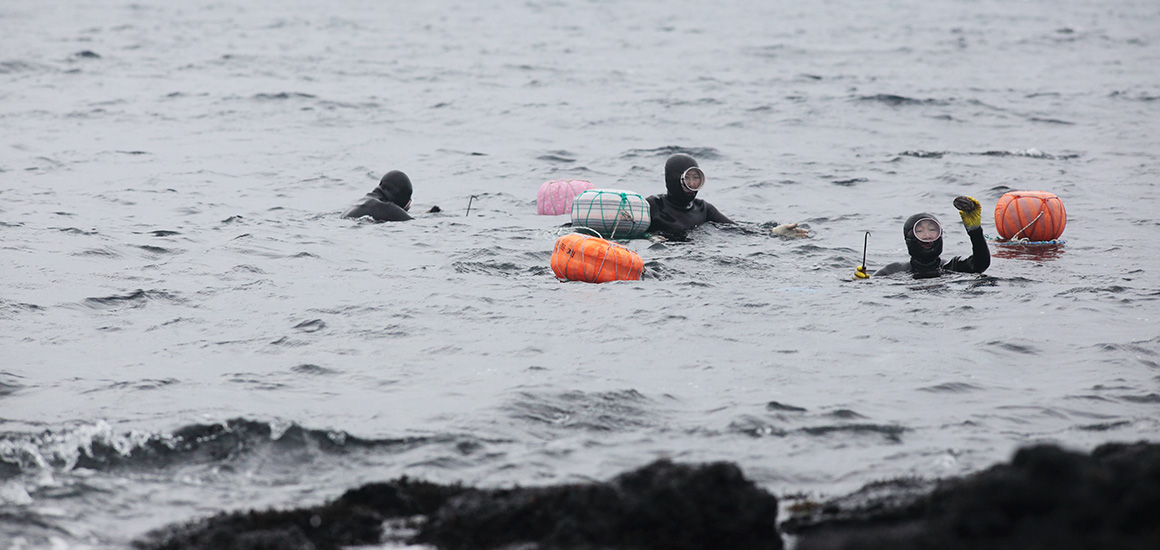
The destiny of Jeju women turns into an 'orange flower'Jeju HaenyeoWhen you walk along the beach, you will be able to see countless orange “flowers” that decorate the sea of Jeju and hear the sumbisori whistles that resound nearby. These are signs that the haenyeo diving women, the flowers of Jeju, are working under the sea.
Of course, you won’t find them fishing every day. It is not about the size of the waves or how strong or weak the wind is. Rather, the haenyeo work according to the tides. The days that the Jeju haenyeo can fish are when the tides are comparatively weak, approximately the 8th to 14th and 23rd to 29th of each month based on the lunar calendar. So based on this calculation, there are only about 100 working days out of 365.
Even then, if the weather is poor, it’s hard for the haenyeo to do their work safely. This means that even if you drive all the way into the countryside to see the Jeju diving women, there’s a chance you’ll miss them altogether.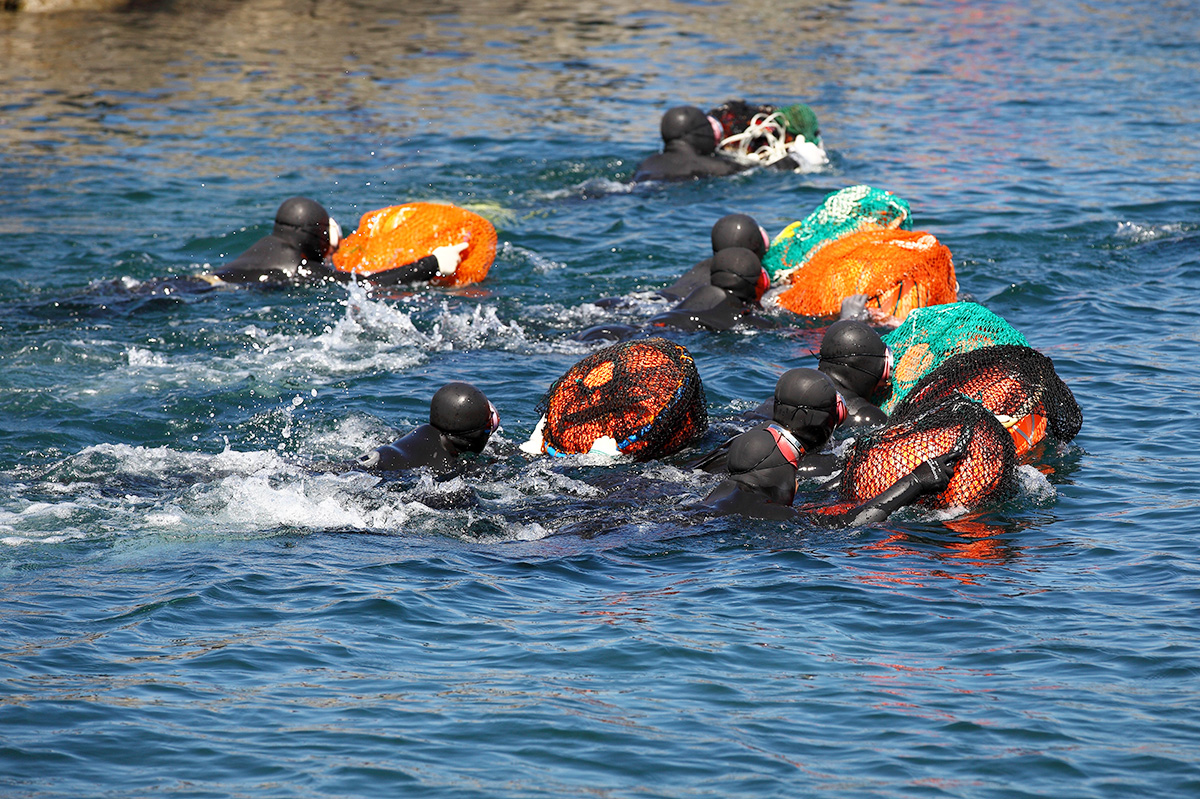
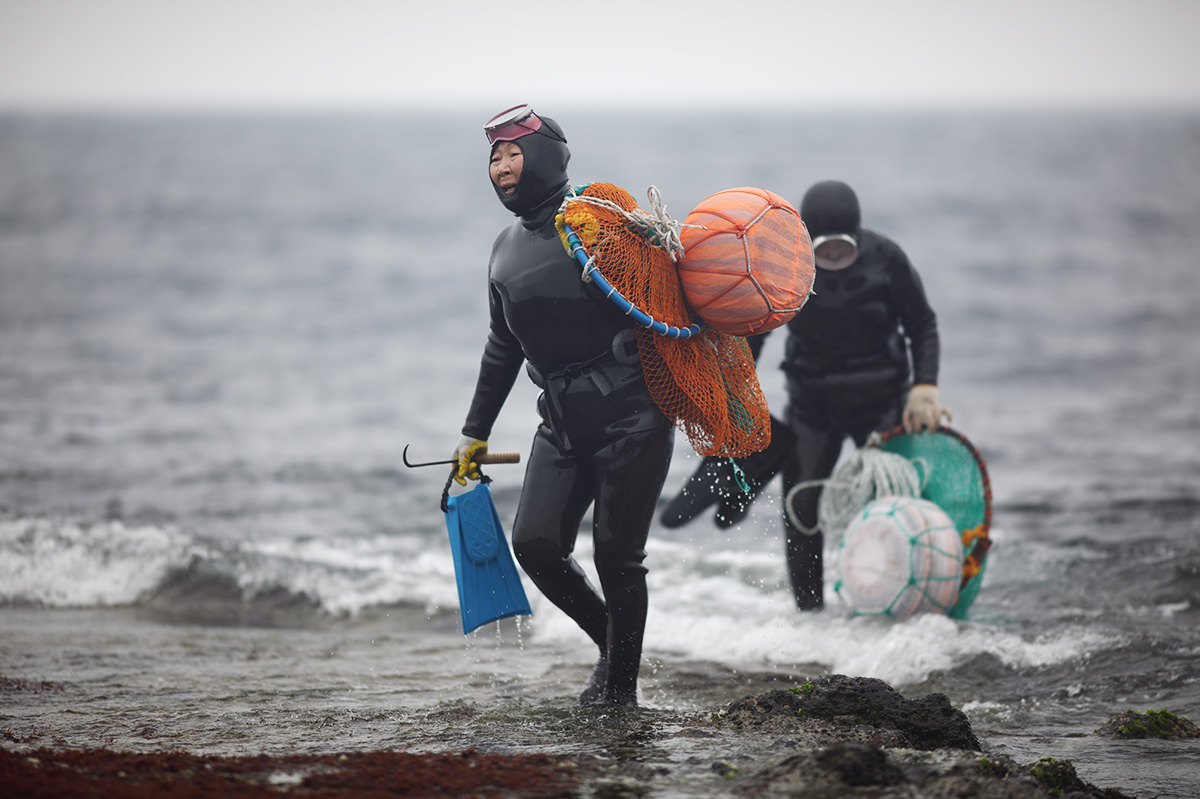
In the old days, the women of Jeju did not have much of a choice regarding their destinies. They had to follow the will of their family, which due to the relative prosperity of those who dove, meant that they, too, would become haenyeo. With their mothers, girls as young as 7 or 8 would start learning to swim at shallow beaches, and by the time they were 12 or 13 would venture into deeper areas along the coast to train.With many years of practise, by the time they were 15 or 16 the Jeju young girls could start working and eventually become strong, independent members of an elite community of divers, women who devote their entire lives to fishing under the sea.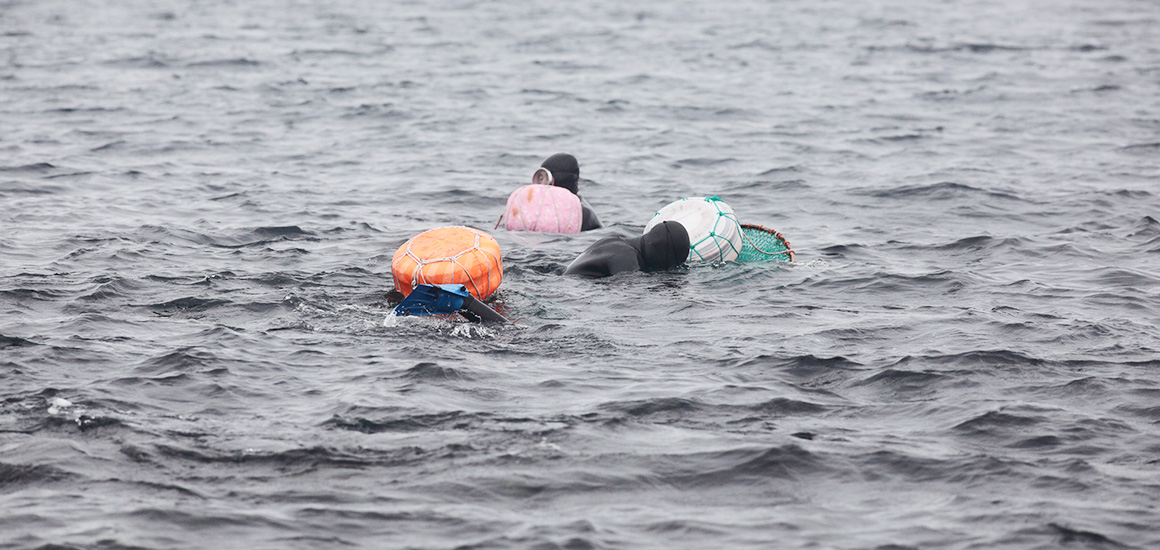
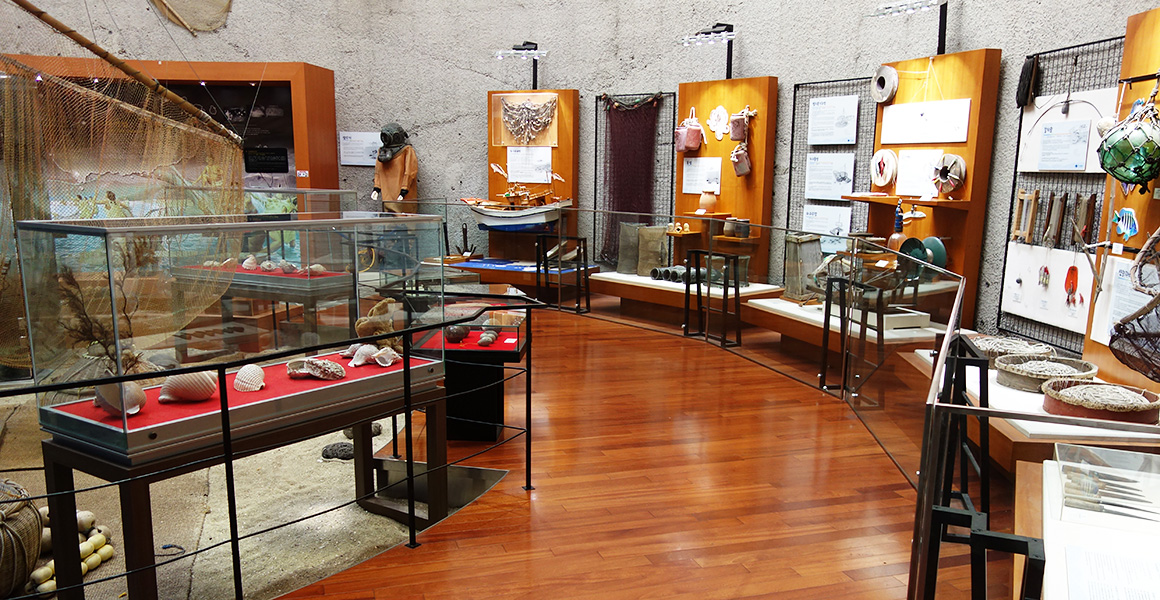
The lives of Jeju haenyeo ‘at a glance’Jeju Haenyeo MuseumIt’s not entirely possible to understand the haenyeo culture and history simply by watching them work in the ocean. Rather, you need to visit the Jeju Haenyeo Museum near Sehwa Beach in Gujwa-eup, Jeju-si. The three-story museum, which opened in 2006, has a total floor area of 4000m2 with three exhibit halls, one theater, an observatory, and one arts hall for children. Each exhibit hall has its own theme. Exhibit Hall No. 1 has the theme of the ‘daily routine of haenyeo’. It recreates a typical haenyeo house, fishing village, and the overall presentation of a fishing village. Exhibit Hall No. 2 has the theme of the ‘workplace of the haenyeo’. It contains information about the women divers’ community and history, as well as a recreated ‘bulteok’ (a space where haenyeo could rest and change in and out of their diving year protected from the strong wind) and other fishing tools. Exhibit Hall No. 3 has the theme of the ‘life of the haenyeo’. Here, visitors can indirectly experience the life of the haenyeo, young women who went from being young girls afraid of the sea to skilled women divers.Jeju Haenyeo Museum정보 자세히 보기 >
Address 26 Haenyeobakmulgwan-gil, Gujwa-eup, Jeju-si

Hours 09:00 ~ 18:00 (Ticketing until 17:00)

Fees Adults: 1,100 Won, Students: 500 Won

Bus Take intercity bus number 701 at Jeju Intercity Bus Terminal, get off at the Haenyeo Museum Entrance Bus Stop. It takes around 1 hour and 22 minutes

Parking Free parking available

Web www.haenyeo.go.kr
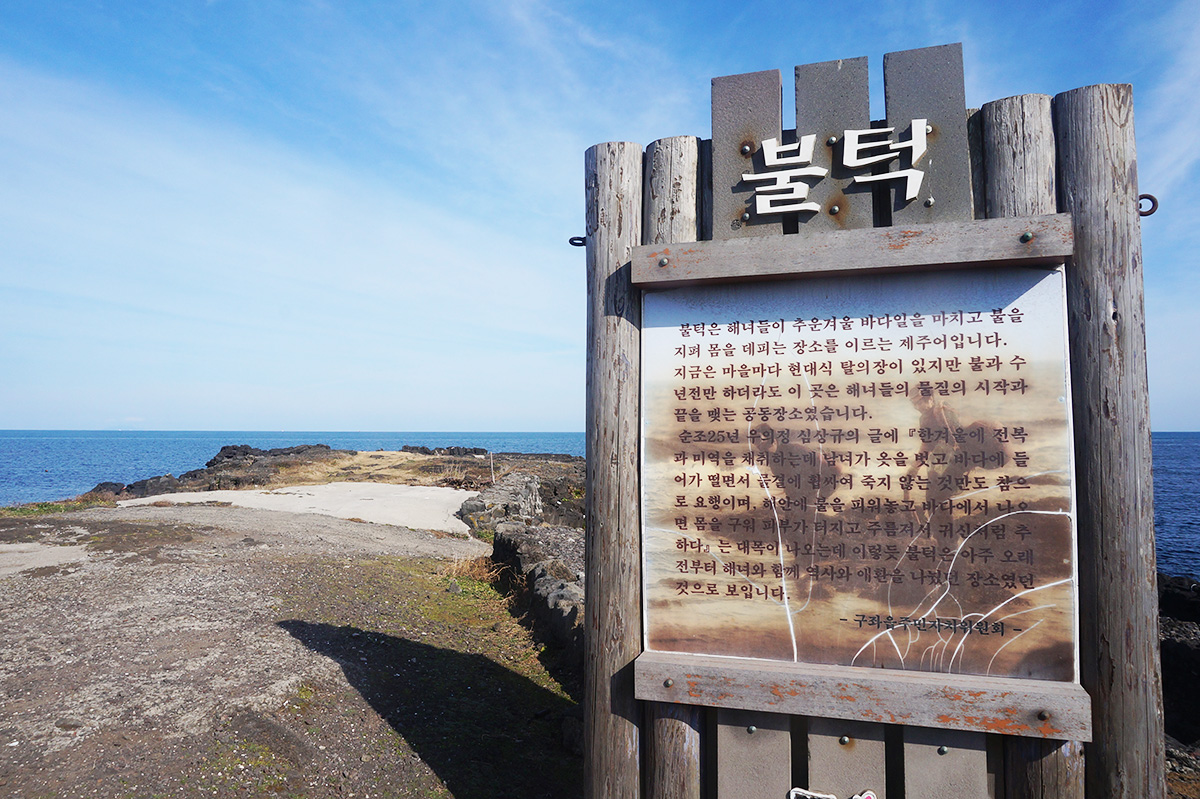
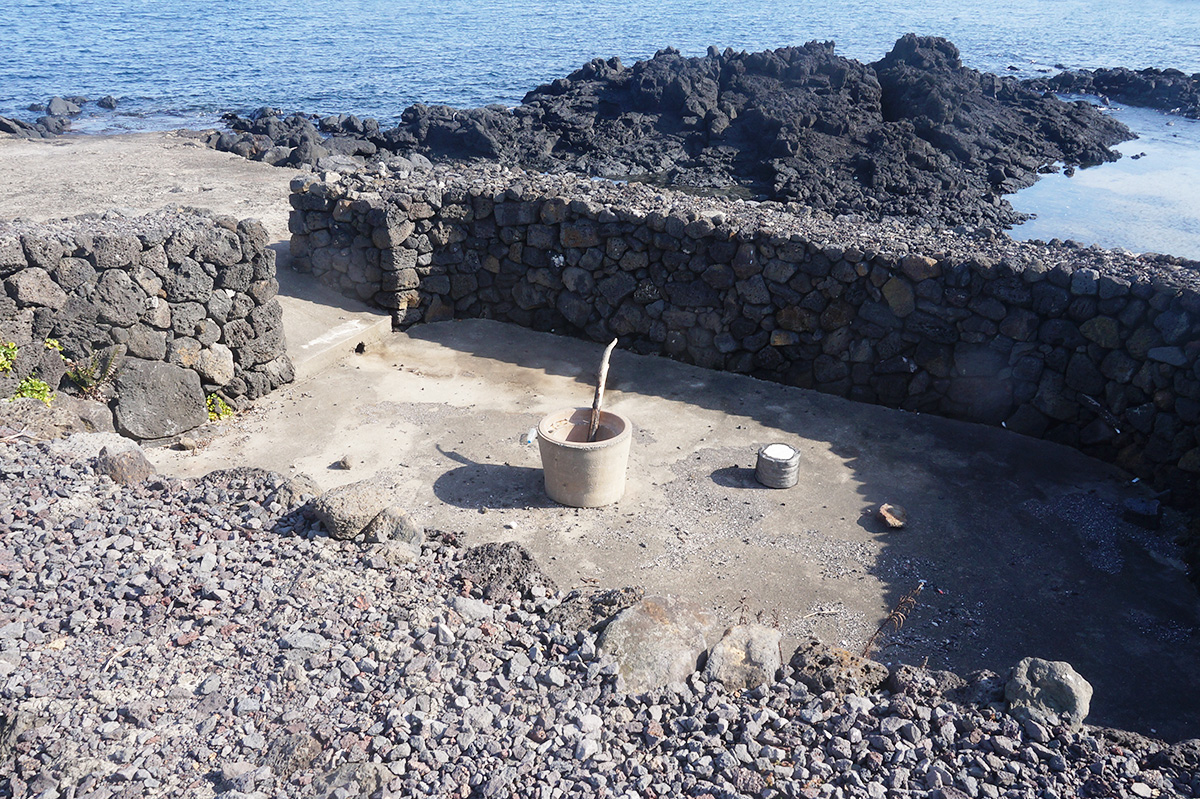
A community space for working haenyeoPyeongdae-ri BulteokNow that you’ve visited the museum and have some general information at hand, it’s time to go check the haenyeo out for yourself. First of all, we will explore a village right next to Sehwa called Pyeongdae-ri and its bulteok. This is a small, walled area with a place to start a fire. The shelter is where haenyeo could either change into or out of their diving gear, or take a rest and warm themselves by the fire. This structure was therefore once very commonly found all around the Jeju coast.
The bulteok is usually a four-sided walled structure that uses rocks from the beach to block the wind. A spot in the center is set for a fireplace. At Pyeongdae-ri, there is a bulteok with a similar structure. The diving women gather around the fireplace based on their rank, and they share their fishing know-how and talk about their families or village news in their down time. These days, with modernized changing rooms, the bulteok is no longer used by haenyeo to change into and out of their diving gear. But you can still find evidence of these bulteok around the island, which hearken back to a simpler time.Pyeongdae-ri Bulteok
Address Pyeongdae-ri, Gujwa-eup, Jeju-si

Bus Take intercity bus number 710 at Jeju Intercity Bus Terminal, get off at Seongsan Pohang Passenger Terminal It takes around 1 hour and 15 minutes

Parking Free parking available
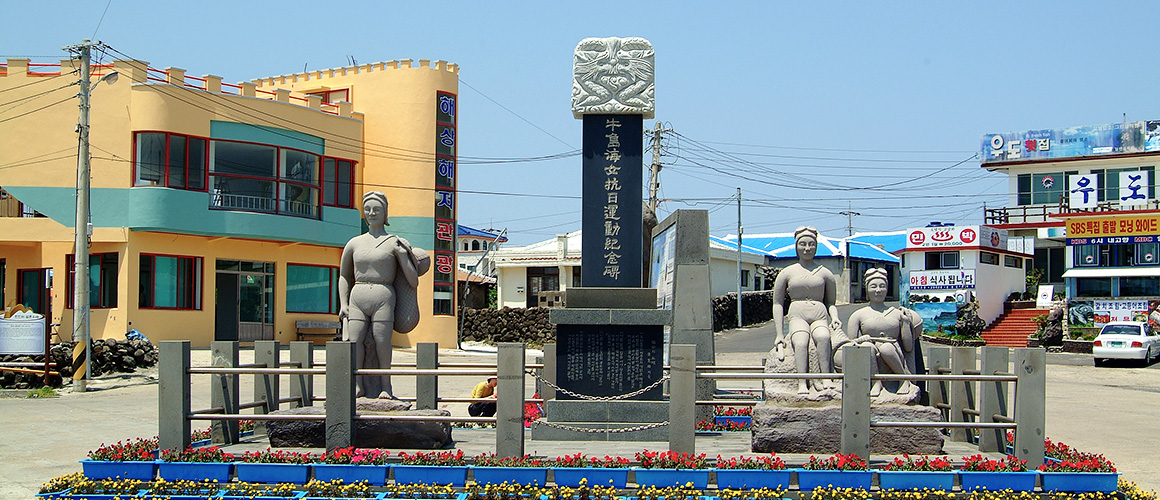
Strong women who fought against oppression and exploitationUdo Island Cheonjinhang HarborUdo Island has recently been the subject of conversation after a documentary about the lives of the haenyeo there was released. There are many diving women who make a living on Udo by heading under the waves. If you go to Cheonjin Harbor, you will see 1.2-meter-tall monument dedicated to the Jeju haenyeo who resisted the Japanese occupation of Korea. During that time, anti-Japanese resistance by haenyeo were primarily led by young teachers at village schools, particularly in Hado-ri and Udo Island.When they were in danger of getting arrested, young teachers in village schools protected them, and once when the police tried to arrest those young teachers, 800 haenyeo stood up for them. Such ardent feelings confronting the Japanese occupation of Korea led to the composition of the ‘Haenyeo Song’. If you stand in front of the memorial monument, please keep the sacrifice and bravery of the Jeju diving women in mind.Udo Island Cheonjinhang Harbor
Address Cheonjin-ri, Udo-myeon, Jeju-si

Fees Entrance (boarding) fee: (Ocean freight one-way) Adult: 2,500 Won, Child: 1,000 Won / (Entrance fee) Adult: 1,000 Won, Child: 500 Won

Bus Take intercity bus number 710 (Jeju.Bonggae.Seongsan Mountain) at Jeju Intercity Bus Terminal, get off at ‘Seongsan Mountain Pohang Passenger Terminal’ l takes around 1 hour 25 minutes

Parking Parking available, 5,000 Won per day
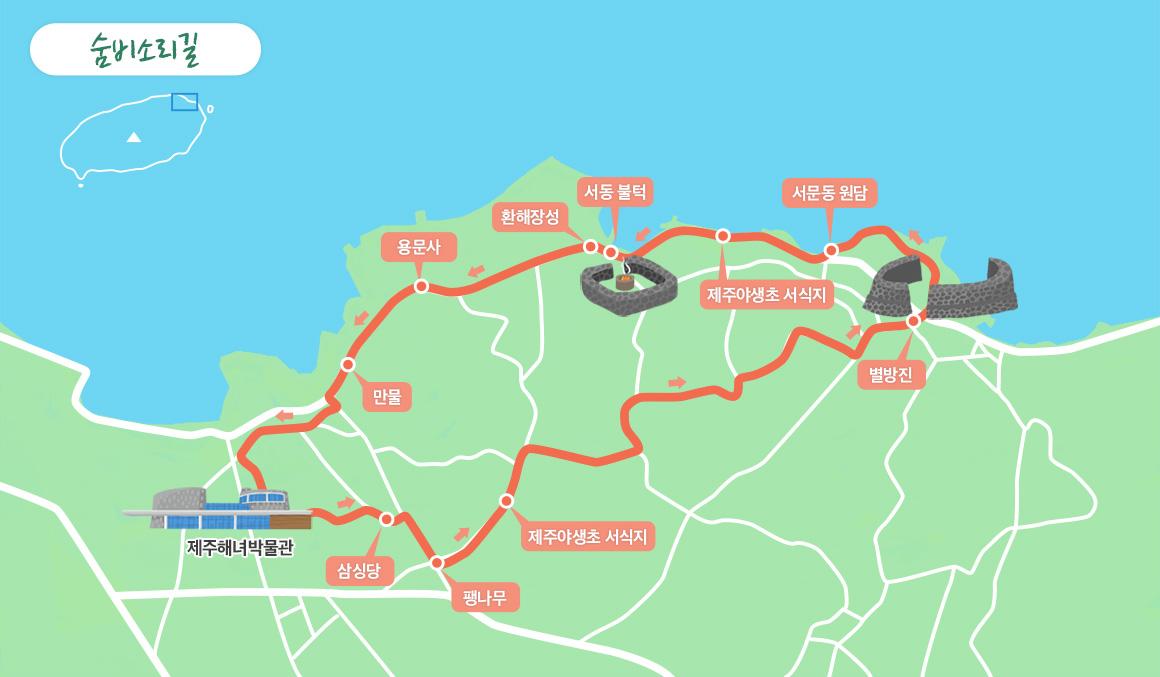
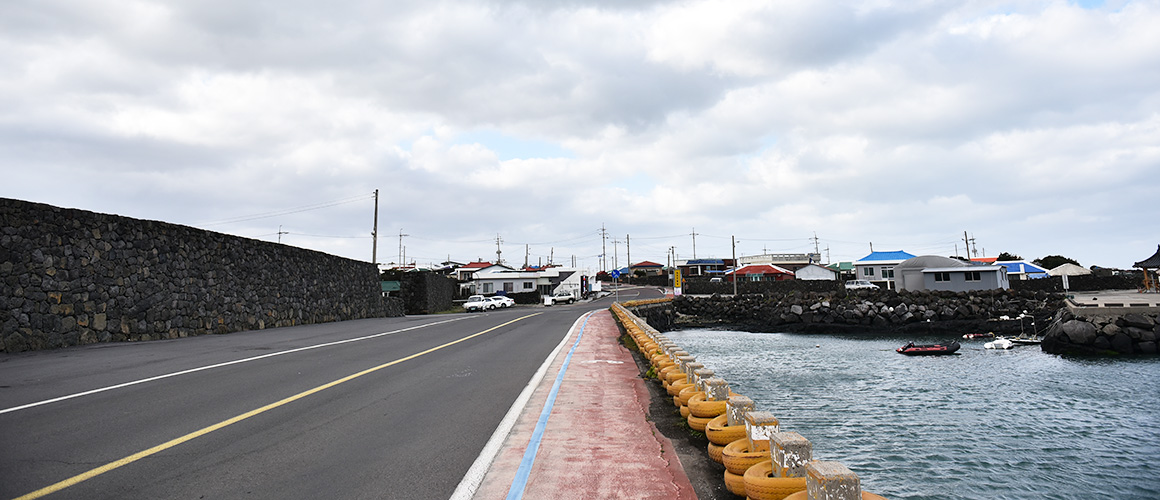
Walking between fields cultivated by haenyeoSumbisori-gil PathOn their way back from diving, the haenyeo carry bags full of marine products as they gaze over the fields along the coast. For them, a good harvest is as important as a good haul of fish. They go out to work in the sea during the proper tides and seasons, but the rest of the year they go back to their farms and take care of the crops. Their life typically is divided between two very different kinds of farming: half on earth and half in the sea. The ‘Sumbisori-gil’ Path, located in Hado-ri, is a good representation of the lives of the haenyeo.
Sumbisori-gil is a circular course with the Haenyeo Museum at its center. The path is about 4.4-kilometers long starting from the Haenyeo Museum, passing through Samsin-sang, Byeolbangjin, Seomun-dong Wondam, Seo-dong Bulteok, Manmul (spring water in Myeonsu-dong), and then back to the starting point. It takes from an hour to one and a half hours for most walkers. The course opened during the Haenyeo Festival in 2012.
The Sumbisori-gil Path, just like its name, connotes the breathing technique used by Jeju haenyeo. Even when you are far from shore, the sharp sound of the diving women coming up for air rings in your ears. Not only that, but on shore, too, the tough and determined women working the fields also sound out their hard work. As you walk along this circular path named after this uniquely Jeju sound, please keep their hard work and determination in mind.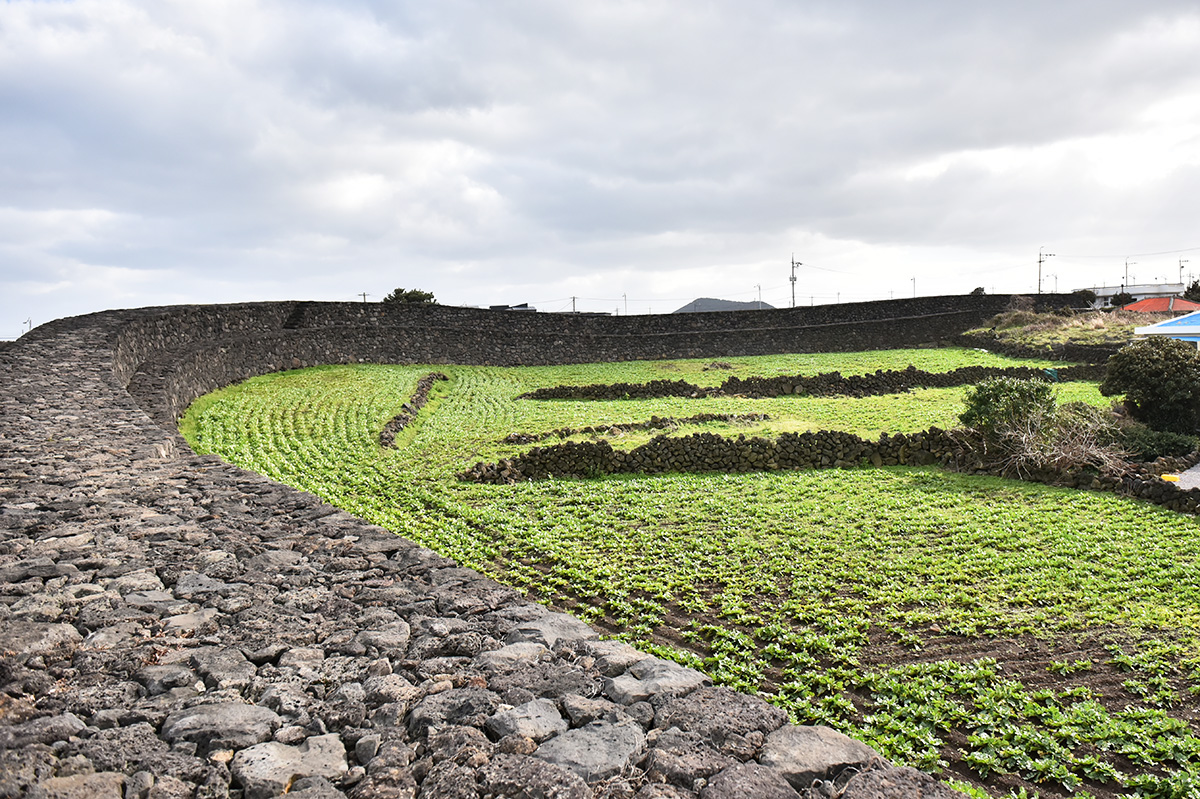
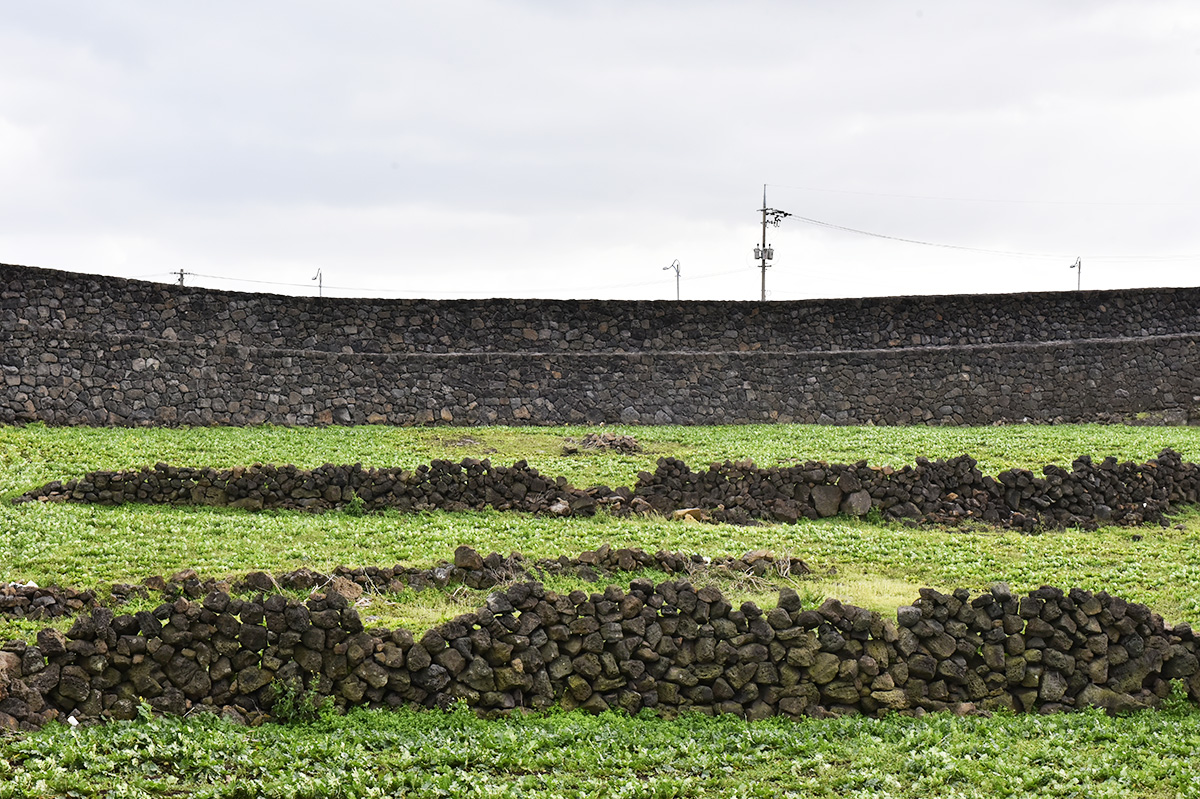
Sumbisori-gil Path
Address Starts from 26 Haenyeobakmulgwan-gil, Gujwa-eup, Jeju-si

Bus Take intercity bus number 701 at Jeju Intercity Bus Terminal, get off at the Haenyeo Museum Entrance Bus Stop. It takes around 1 hour and 22 minutes

Parking Free parking available
- Notice
- Invalid date
- ※ Unauthorized use of the content above (text, photos and videos) is prohibited and subject to copyright by the Jeju Tourism Organization.